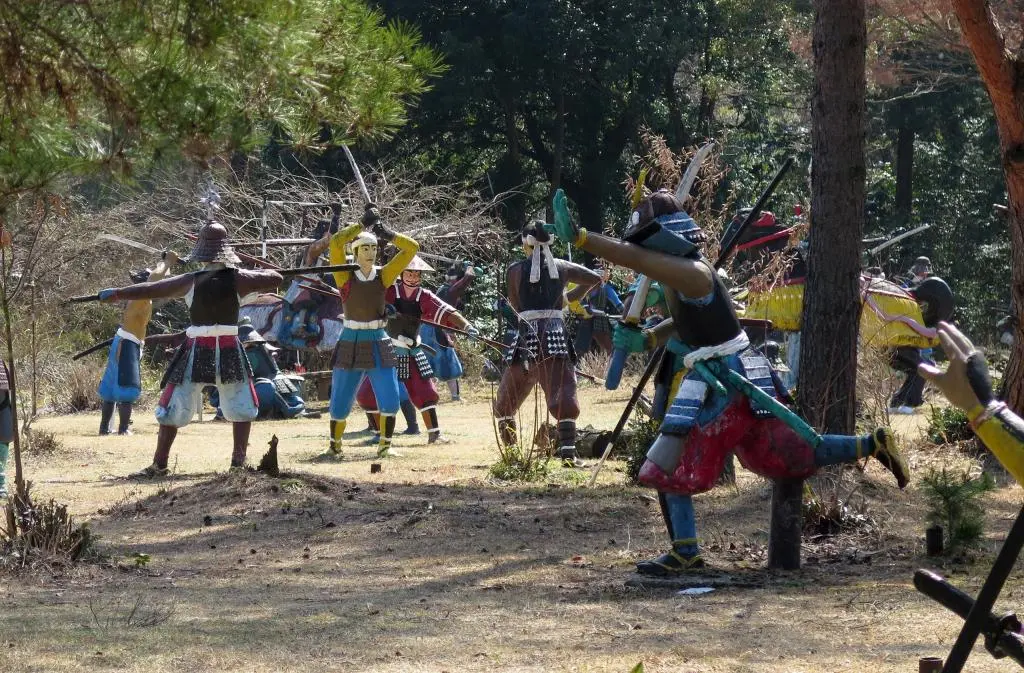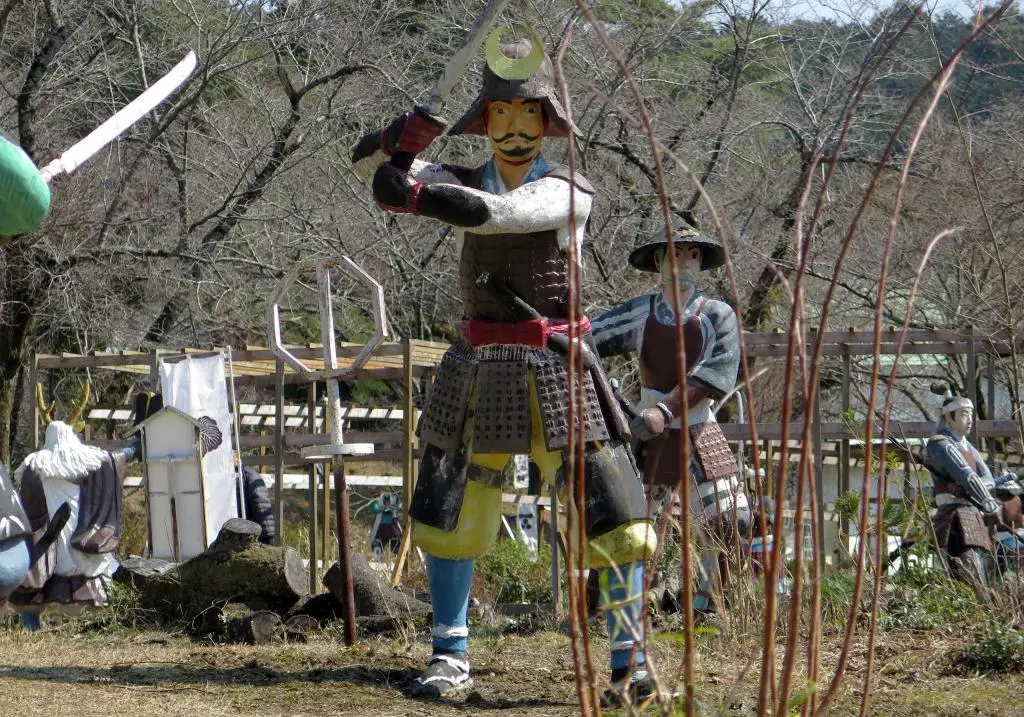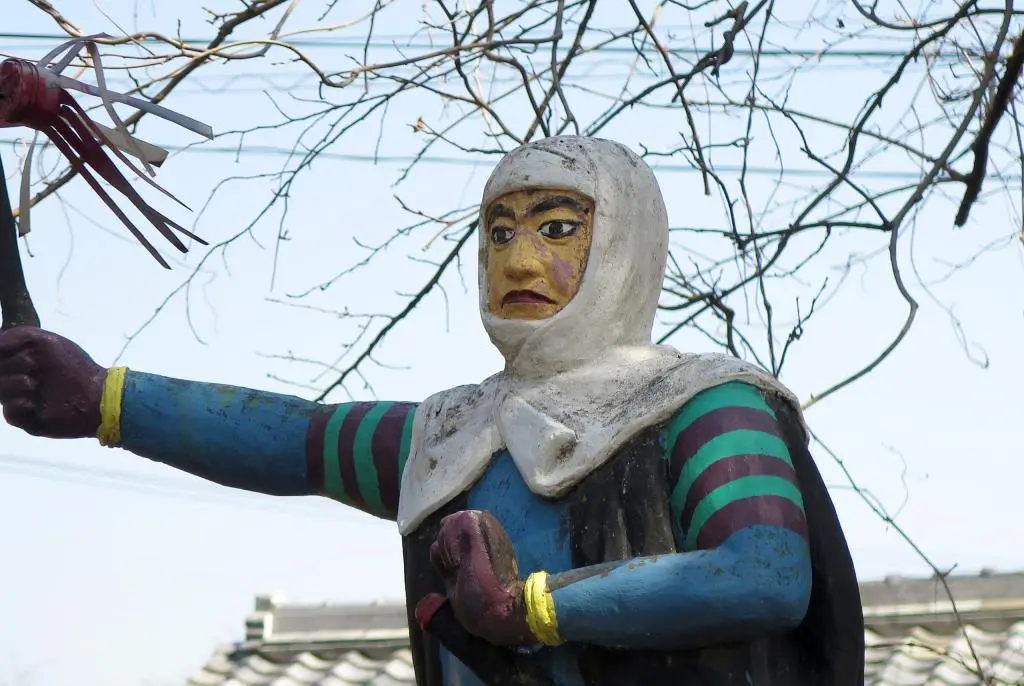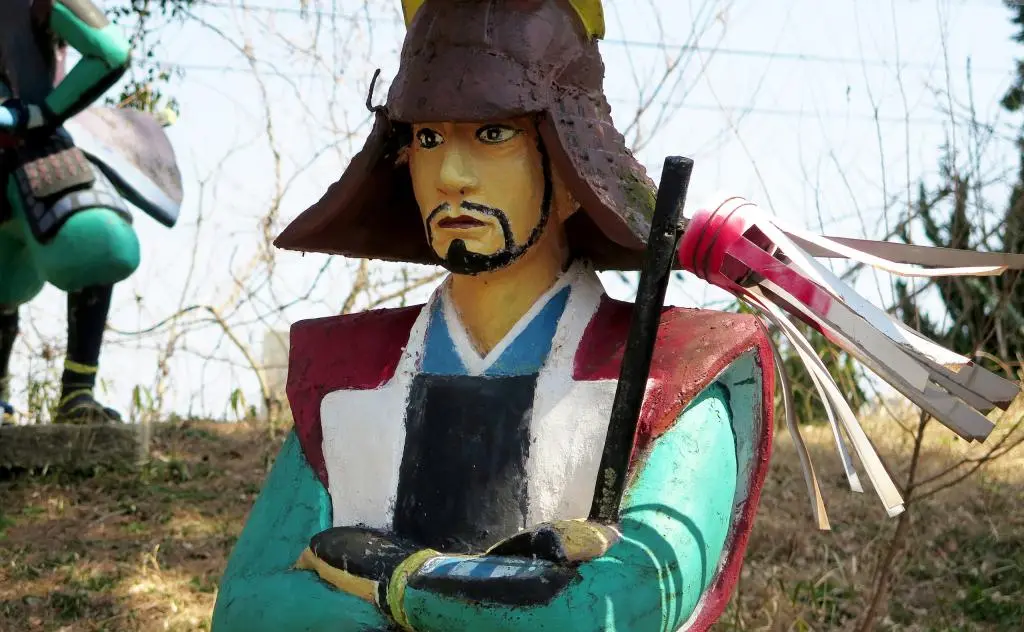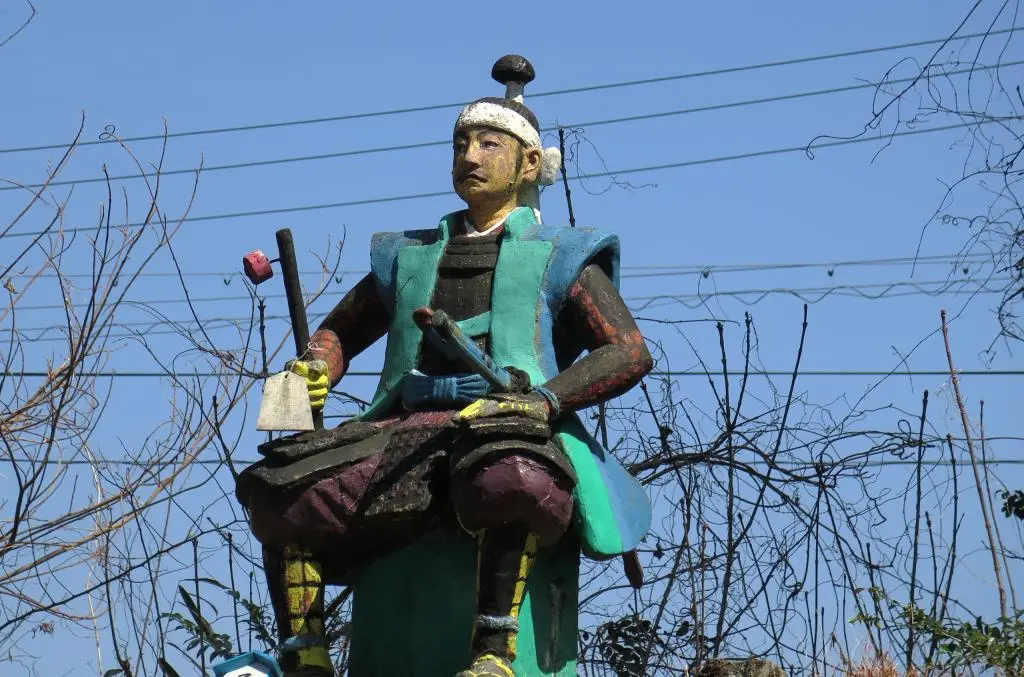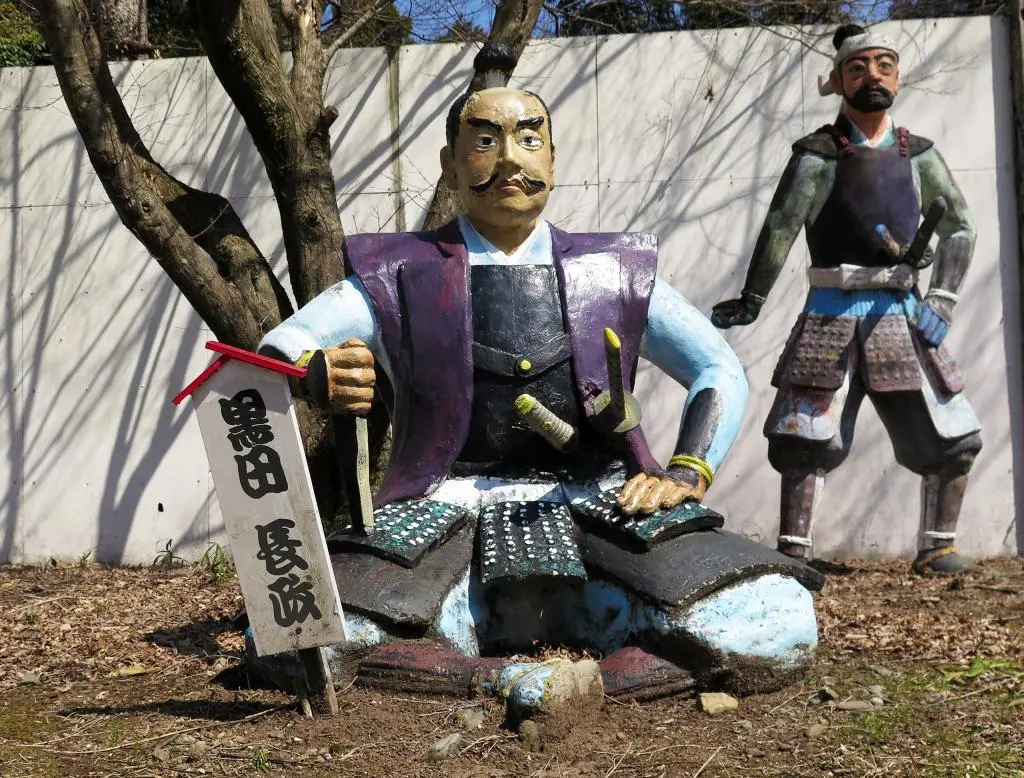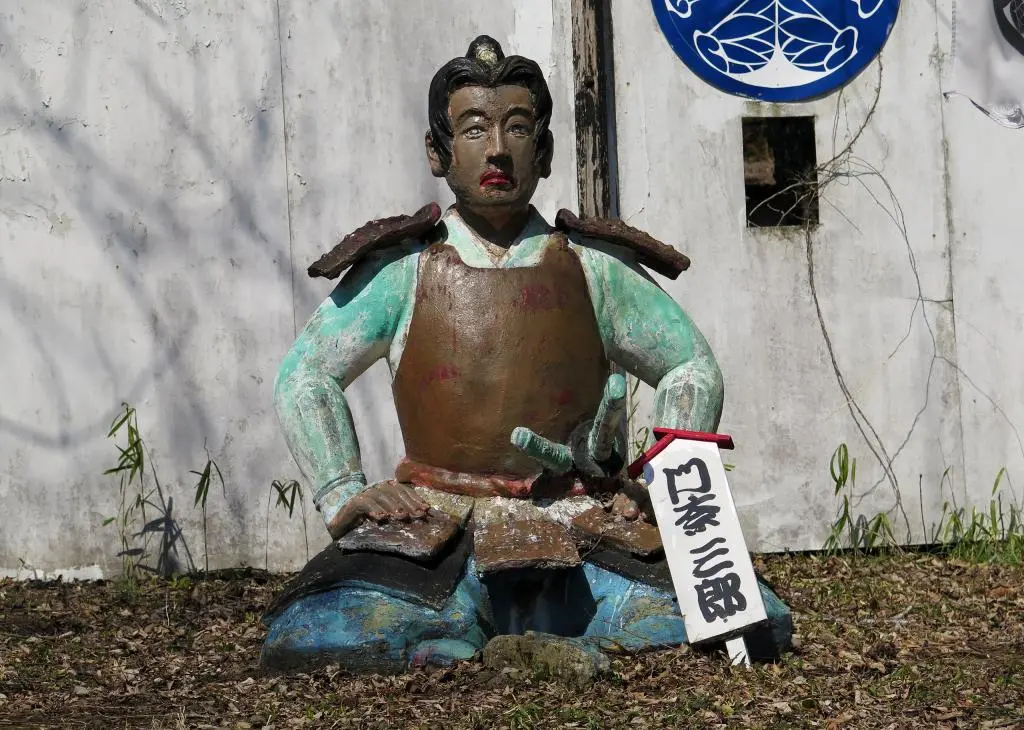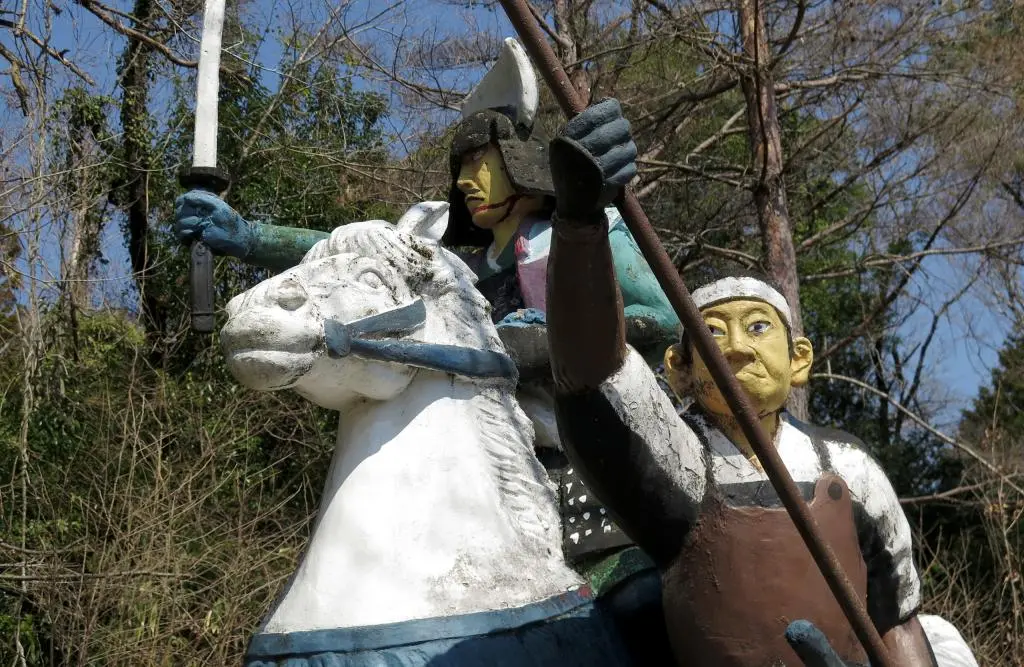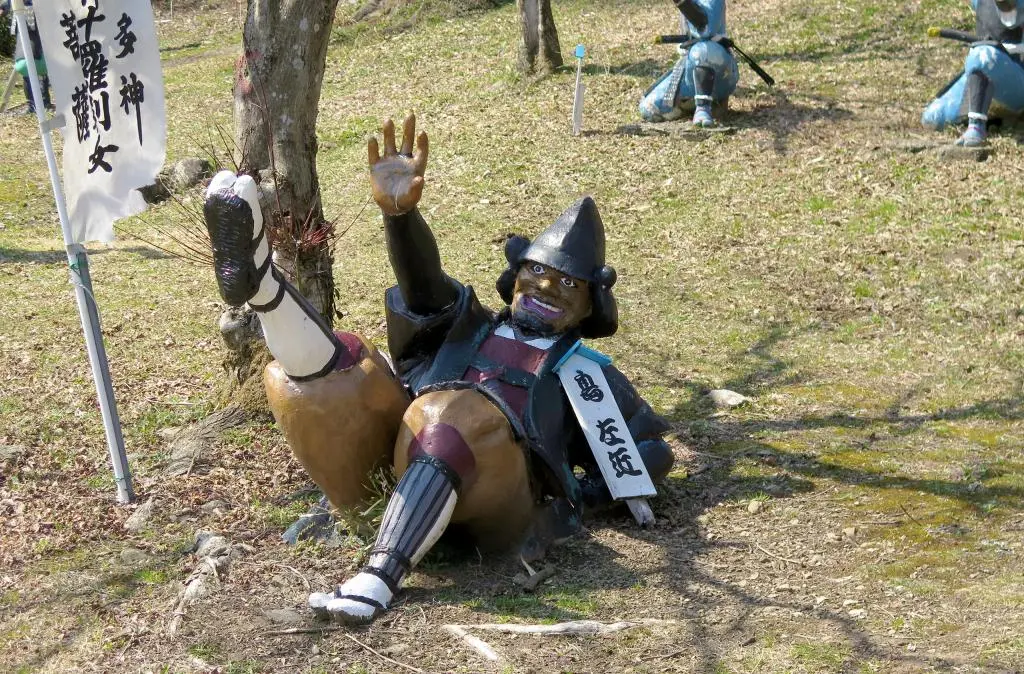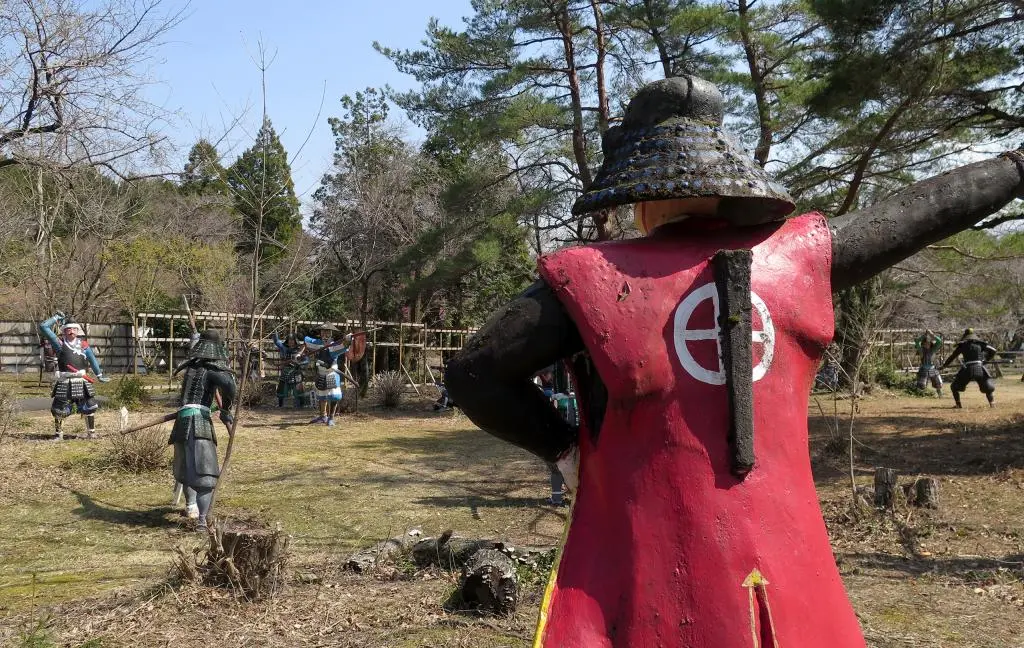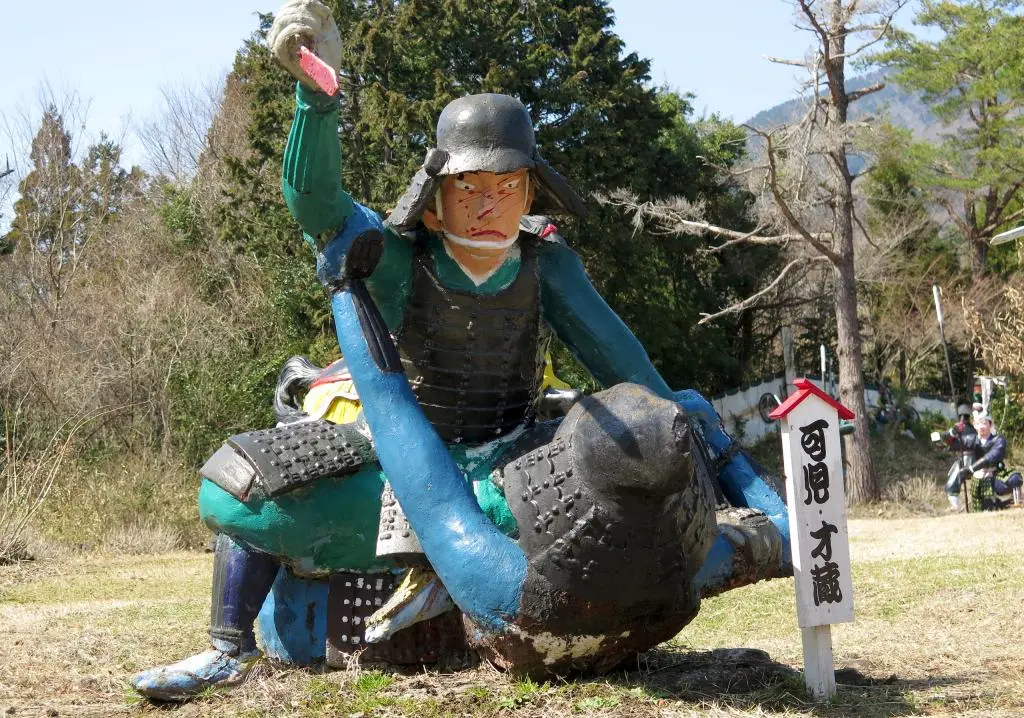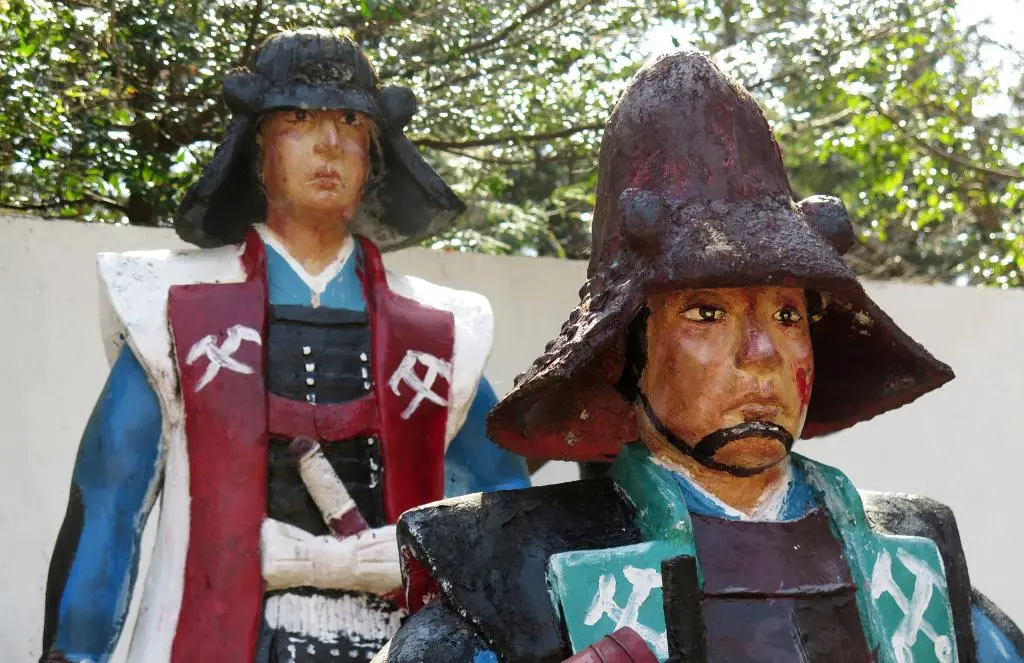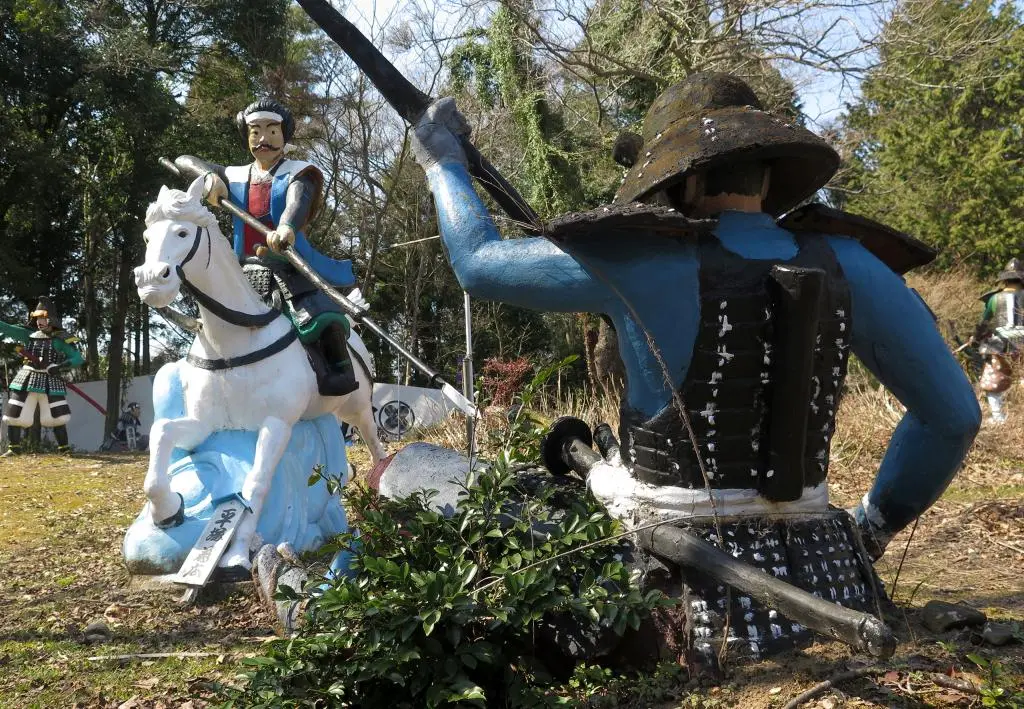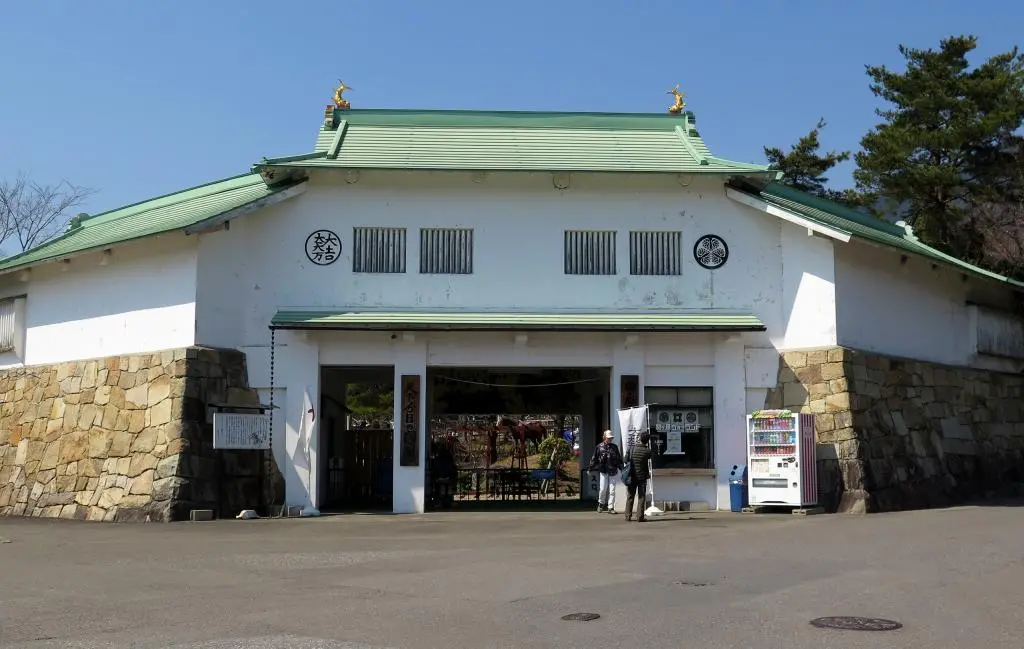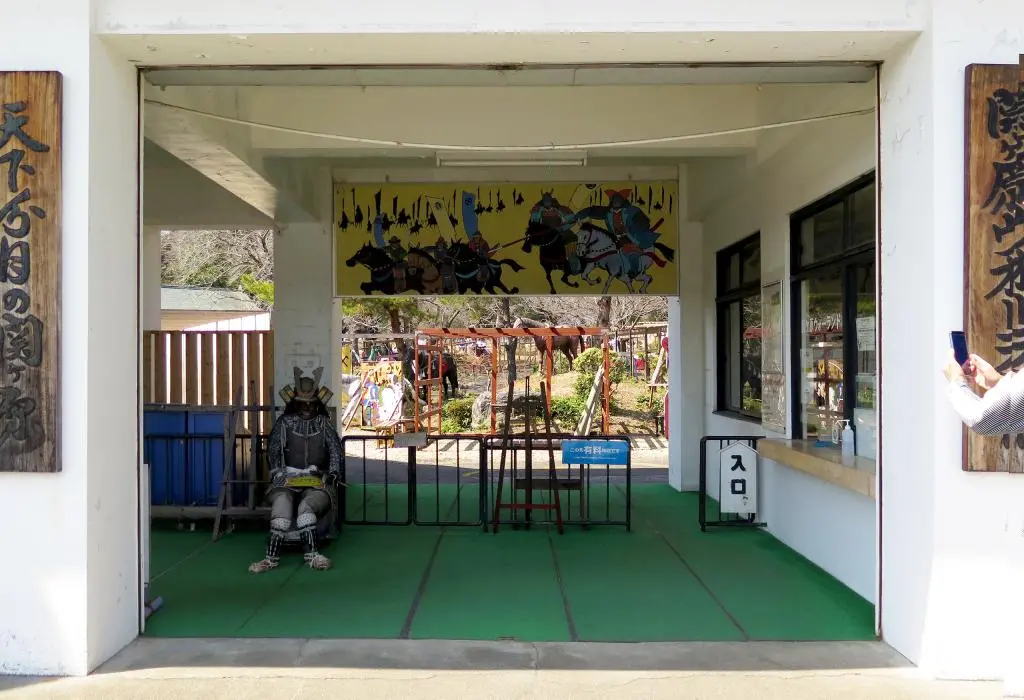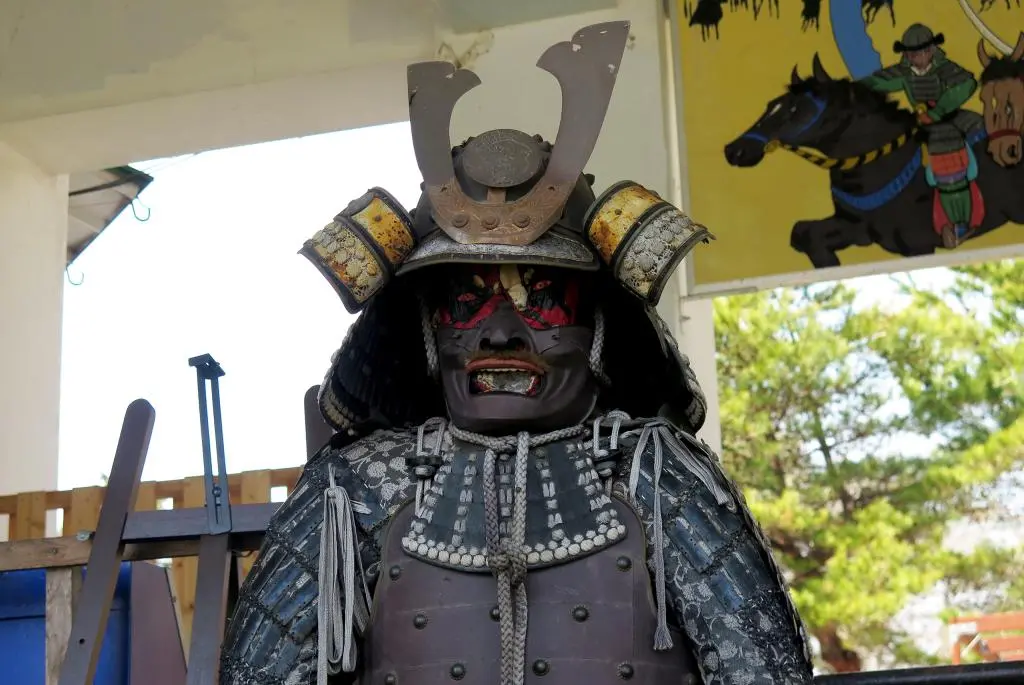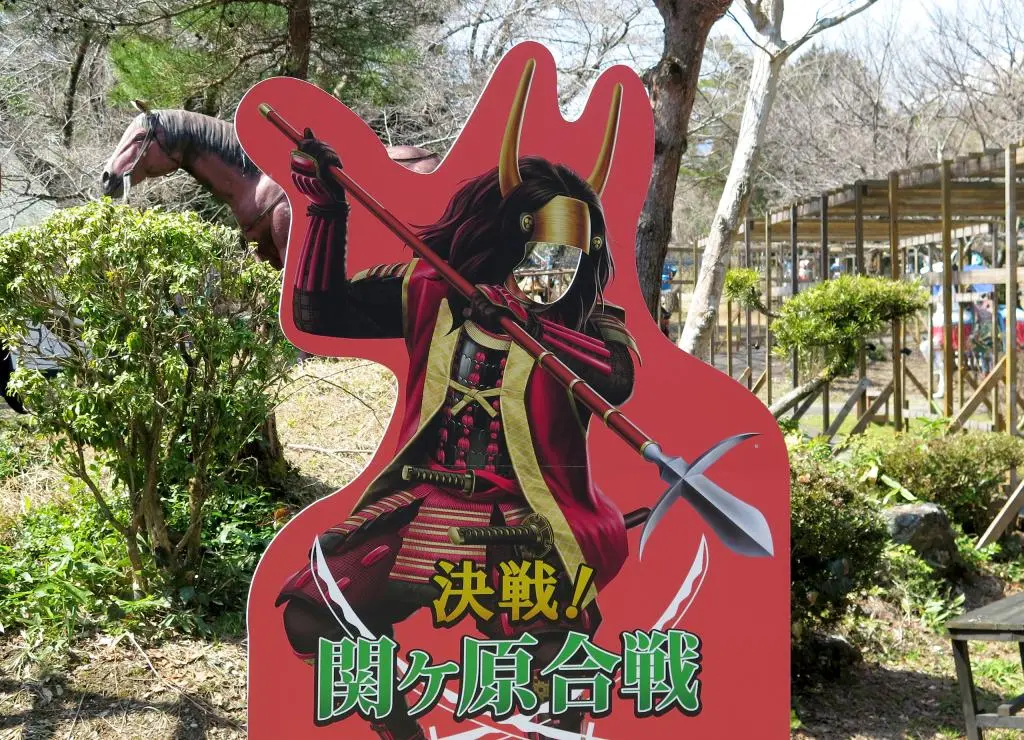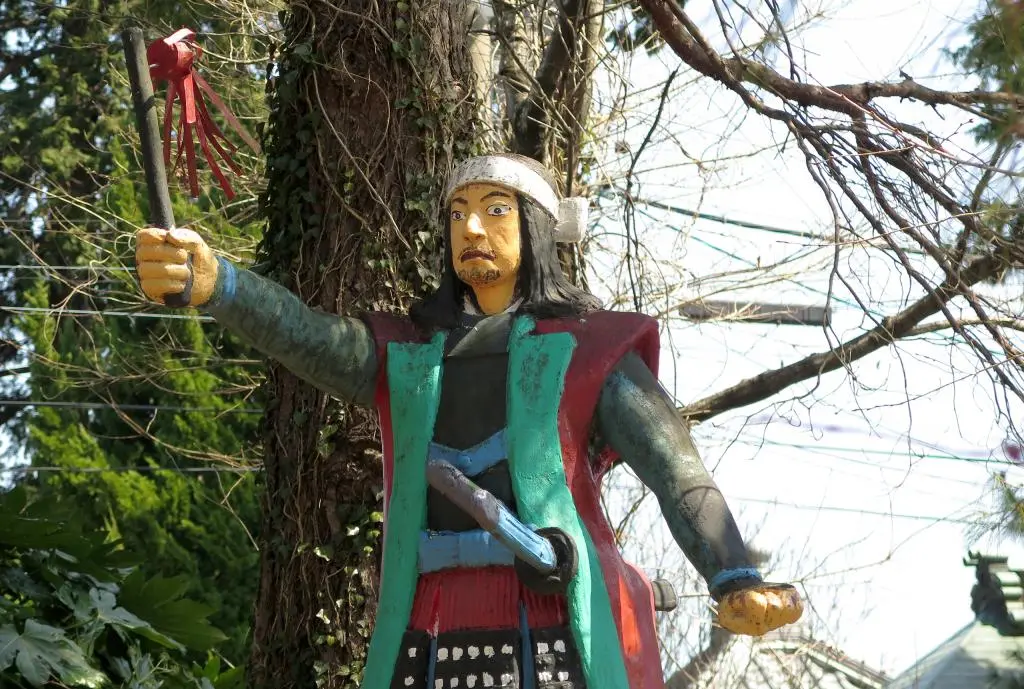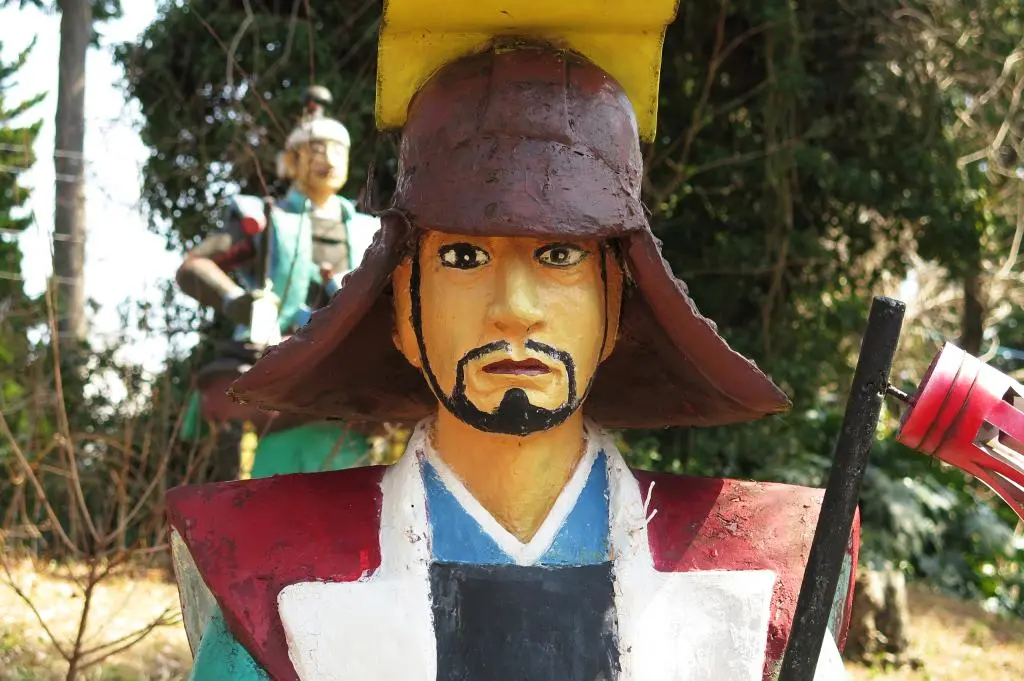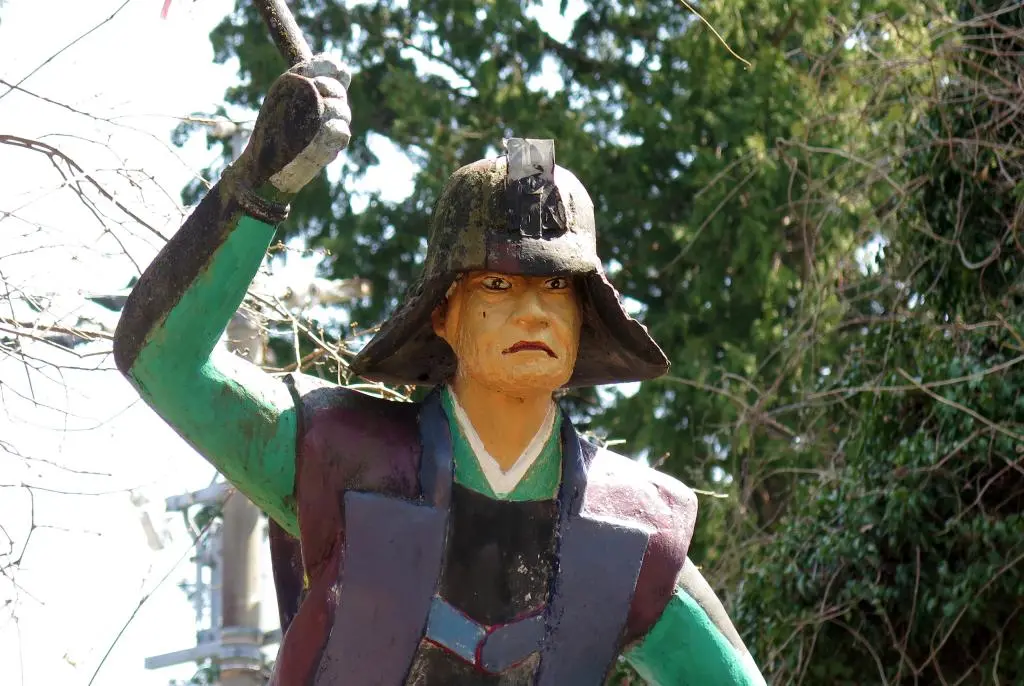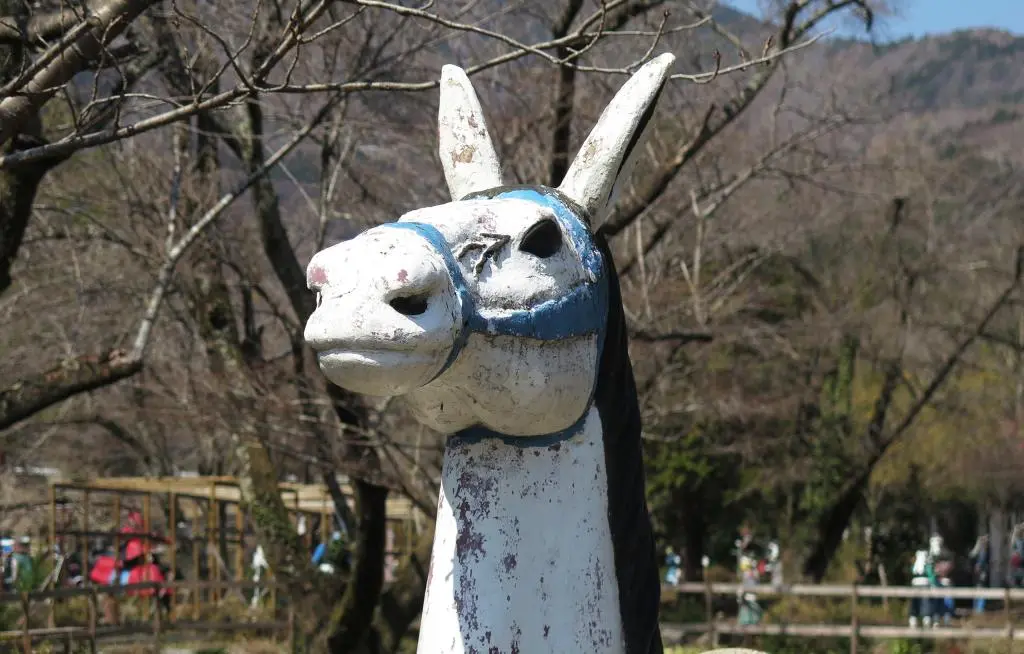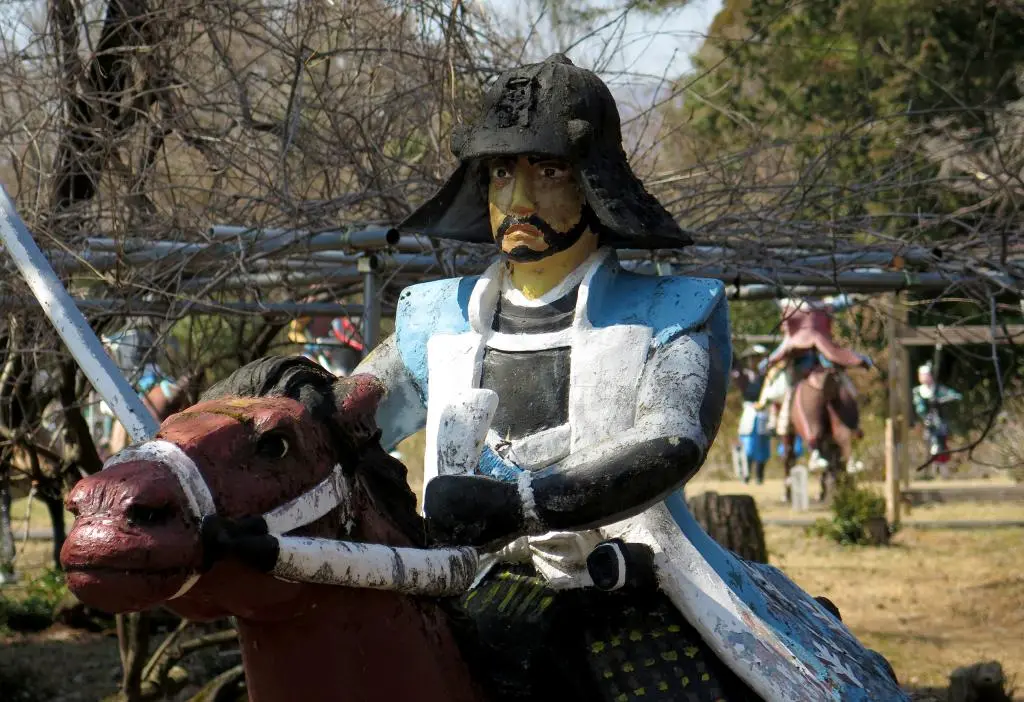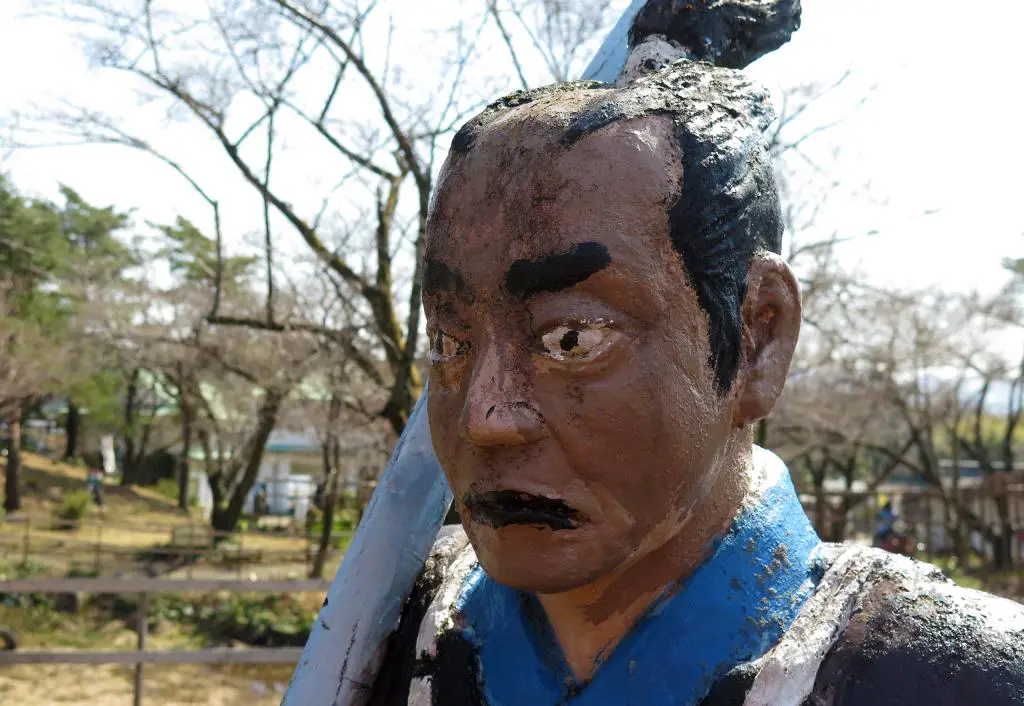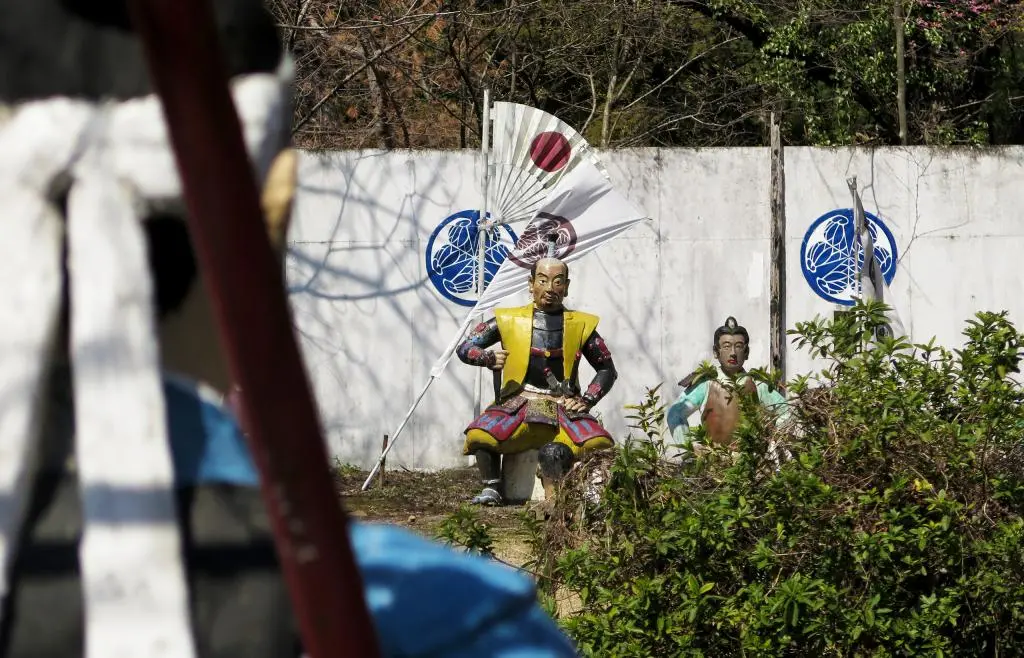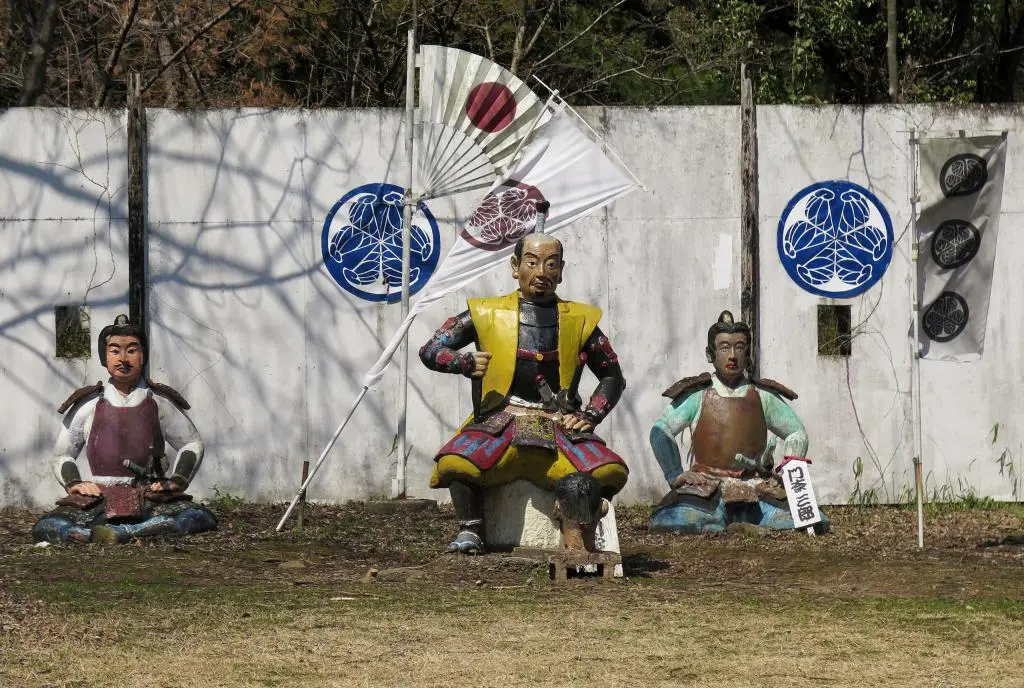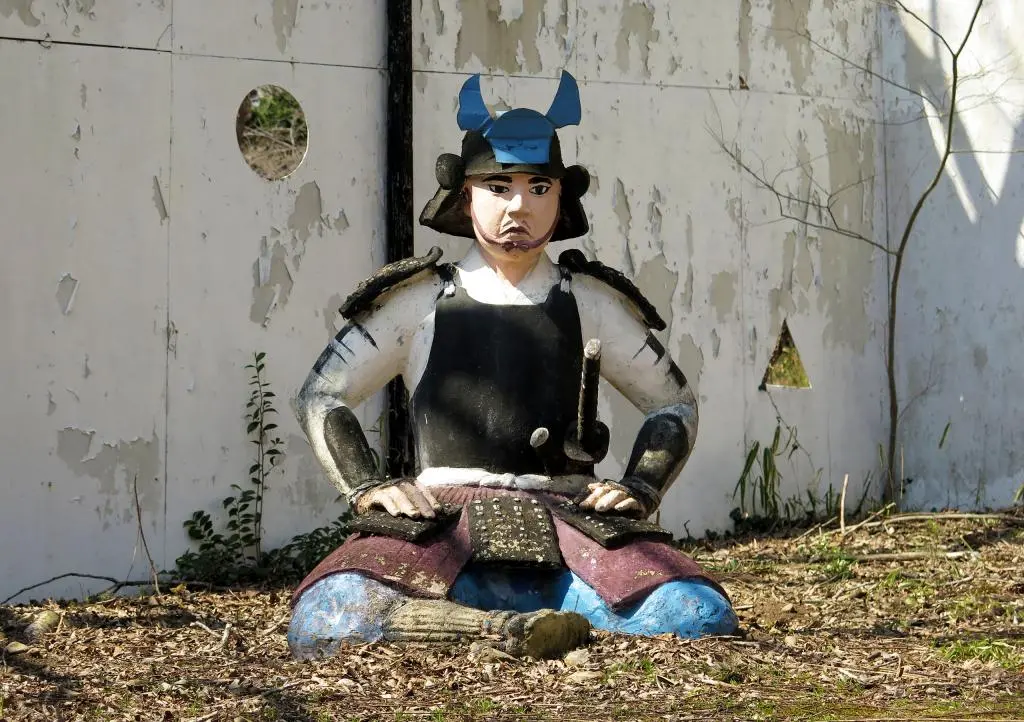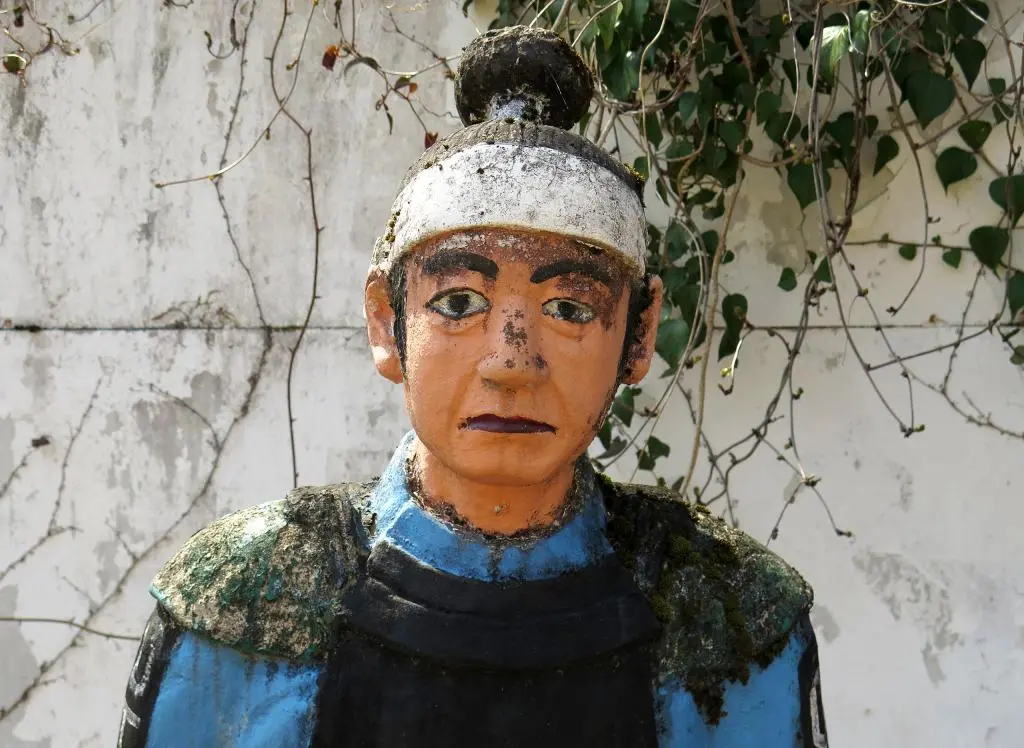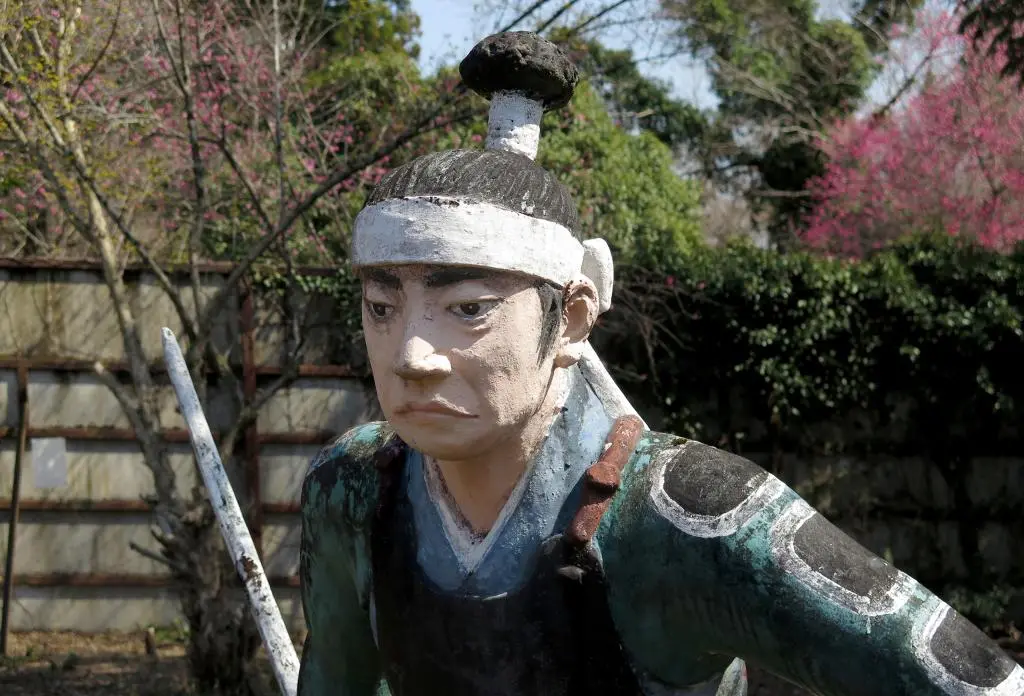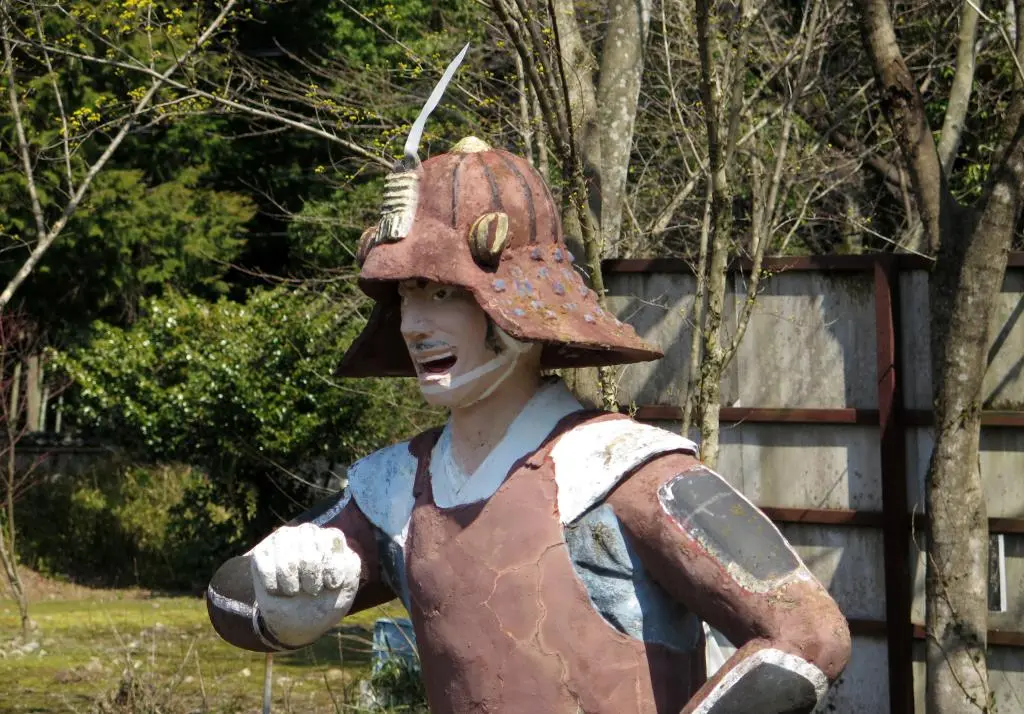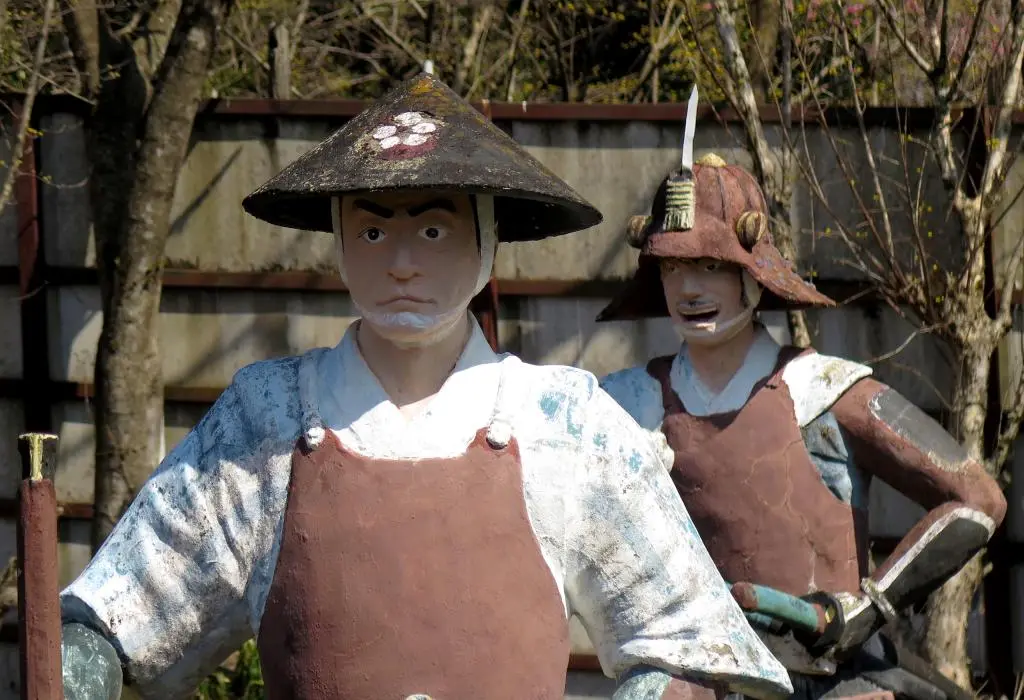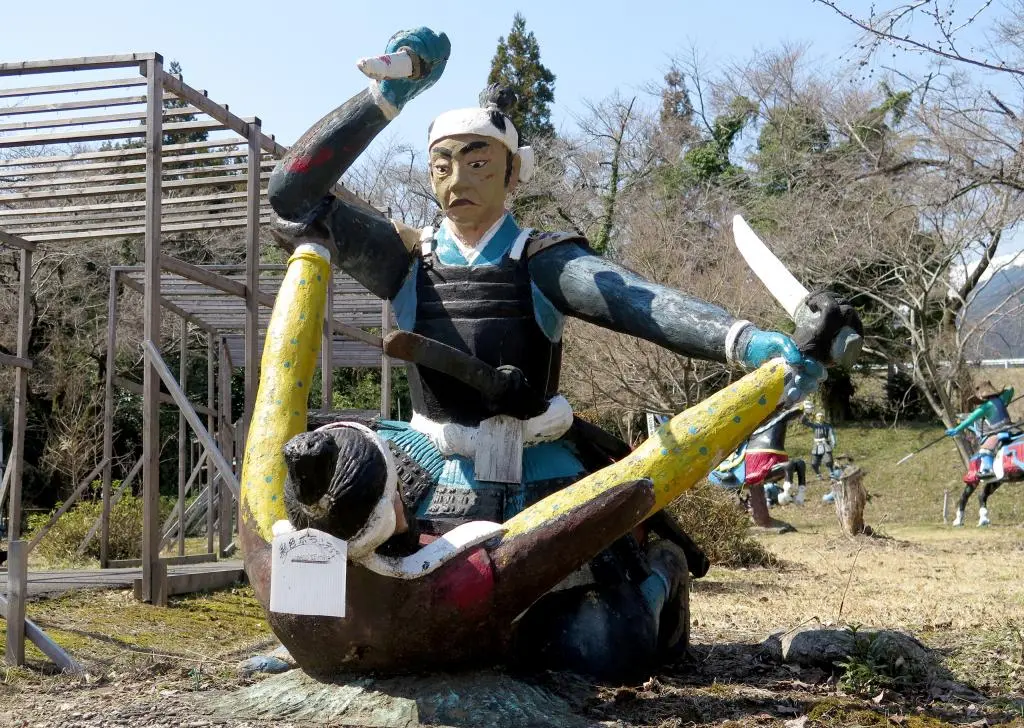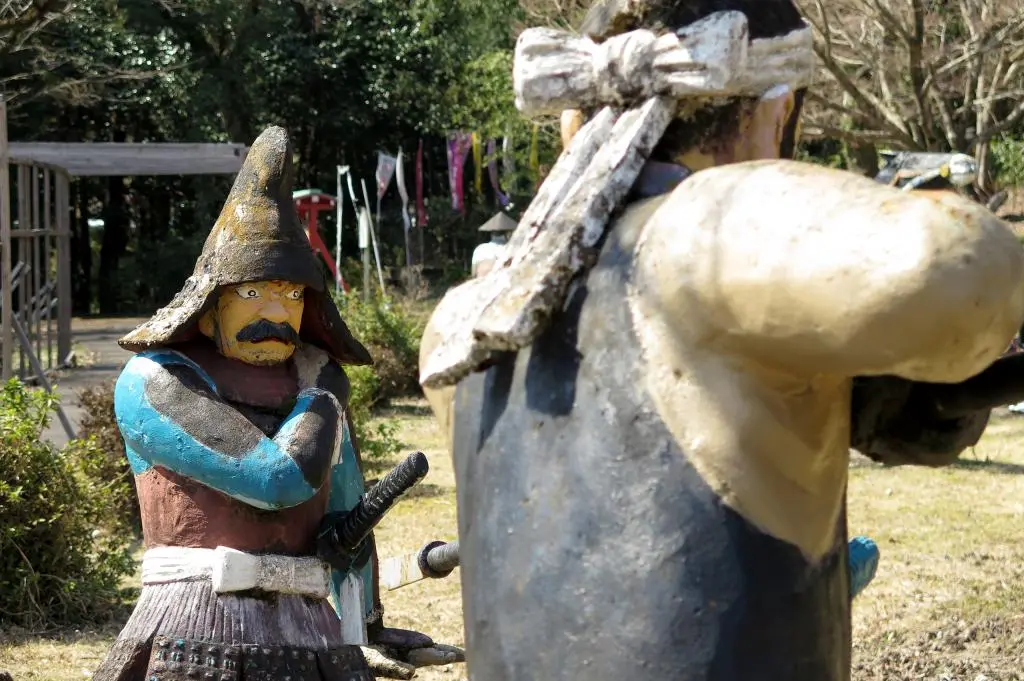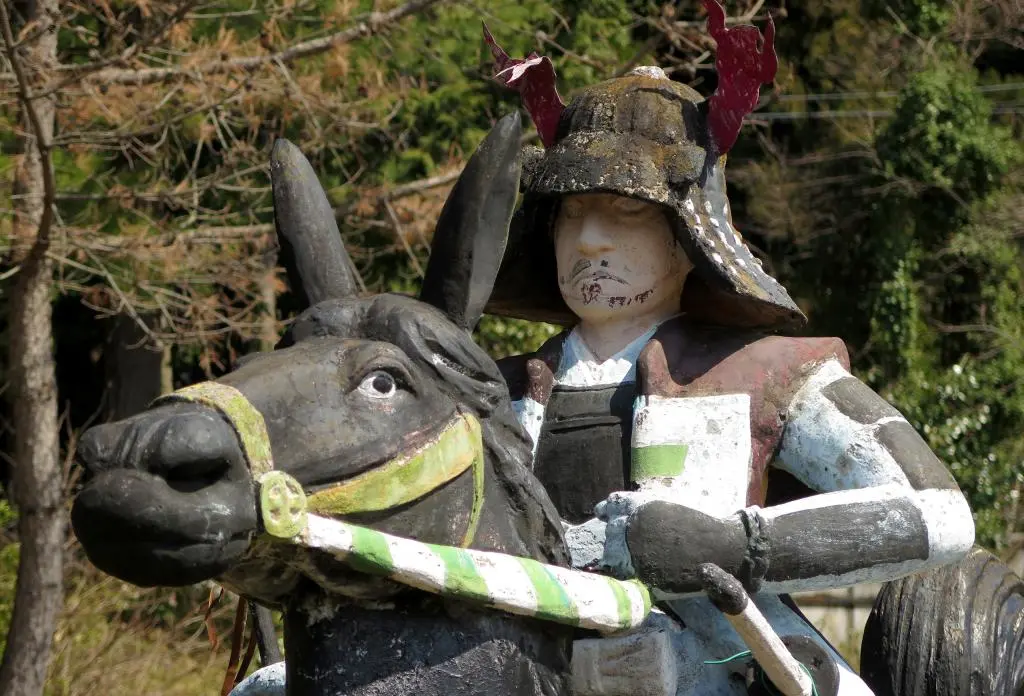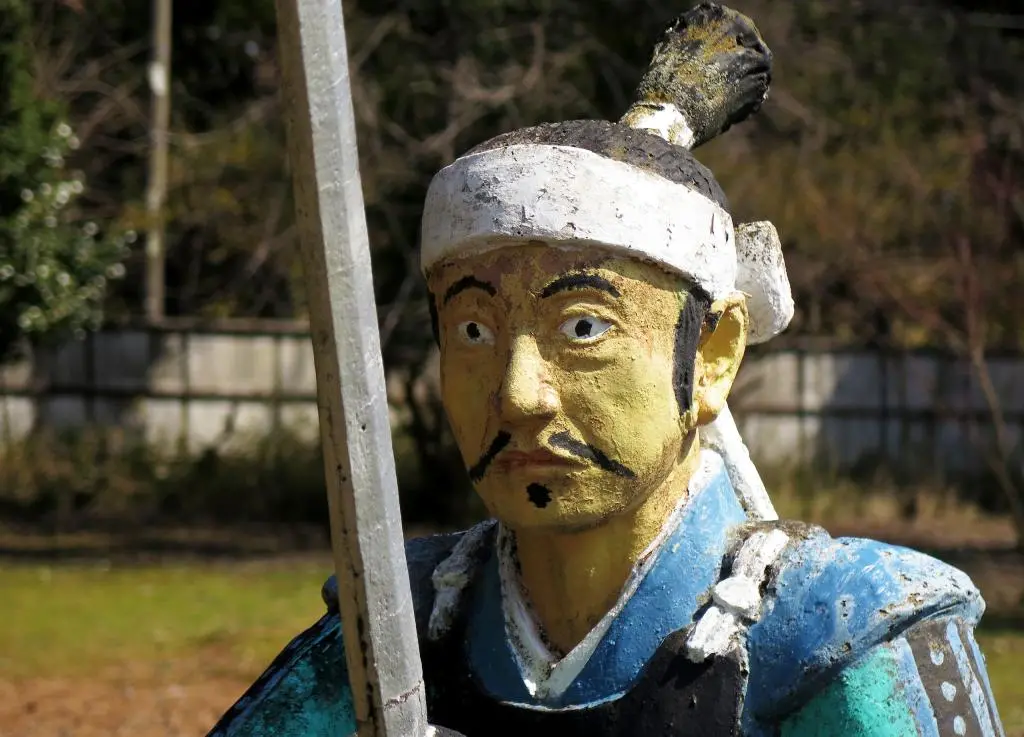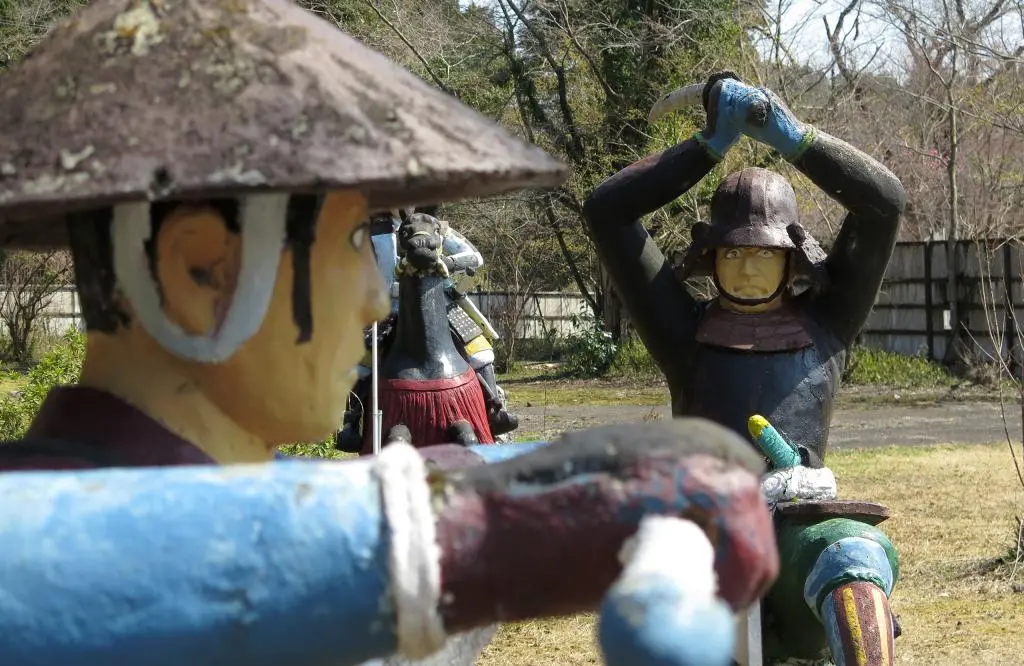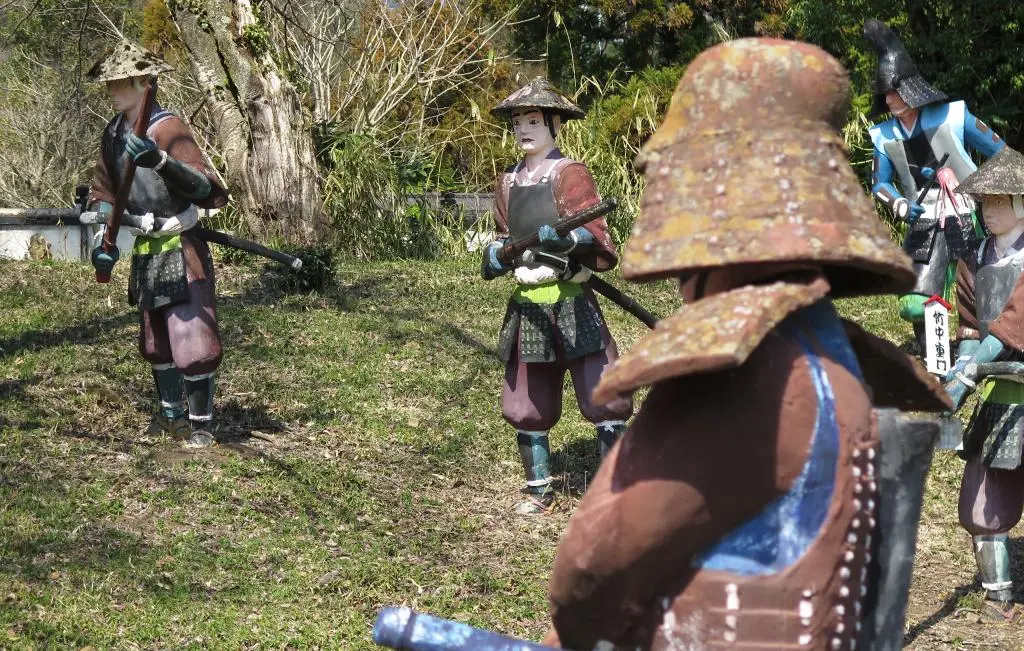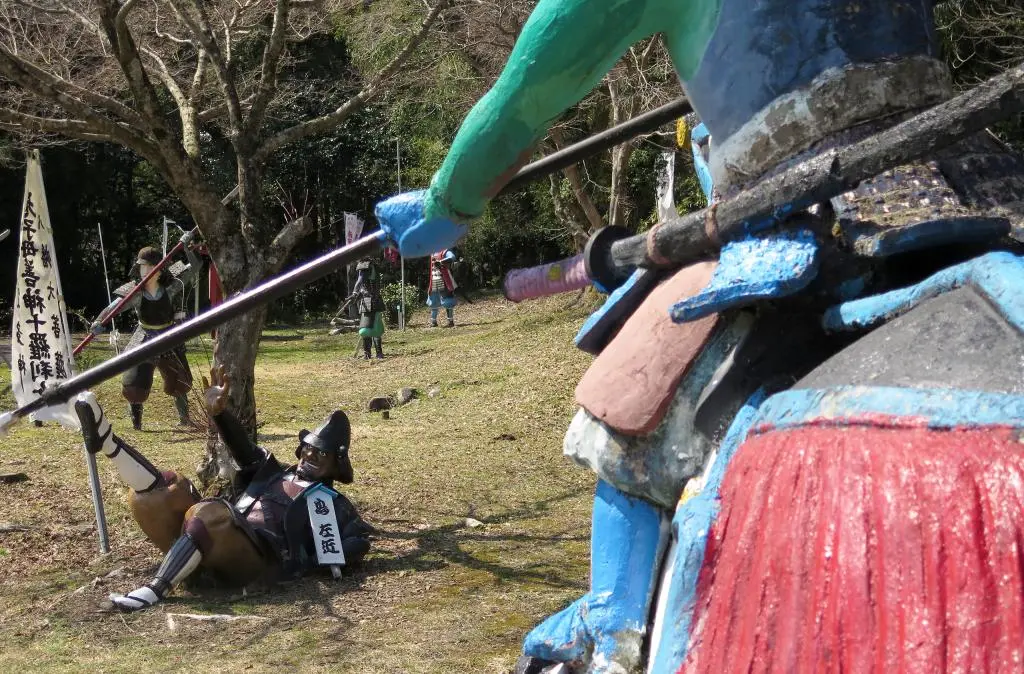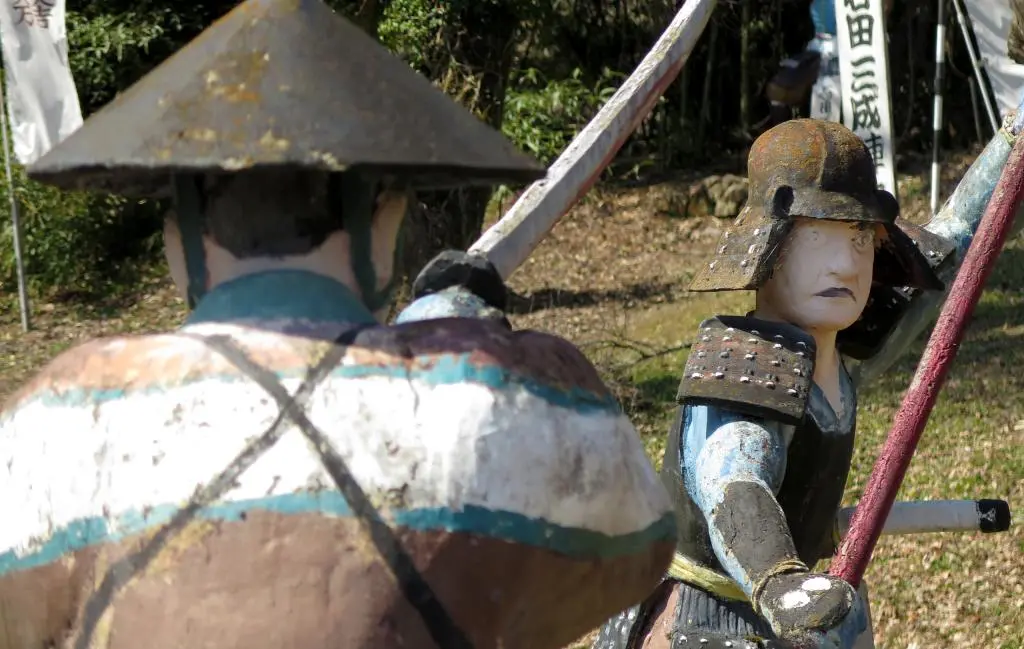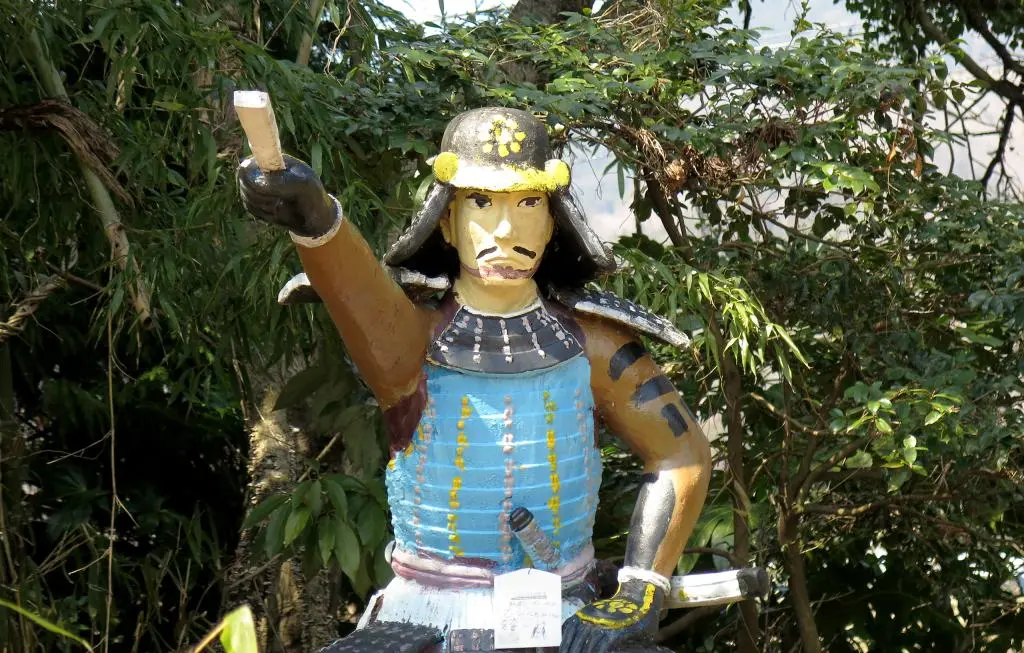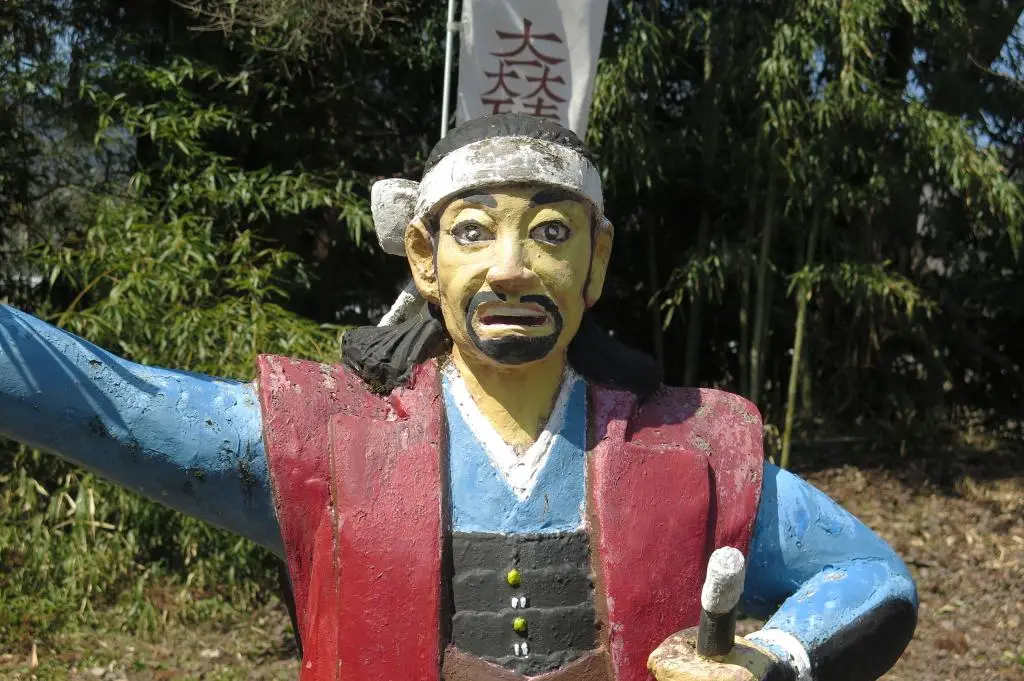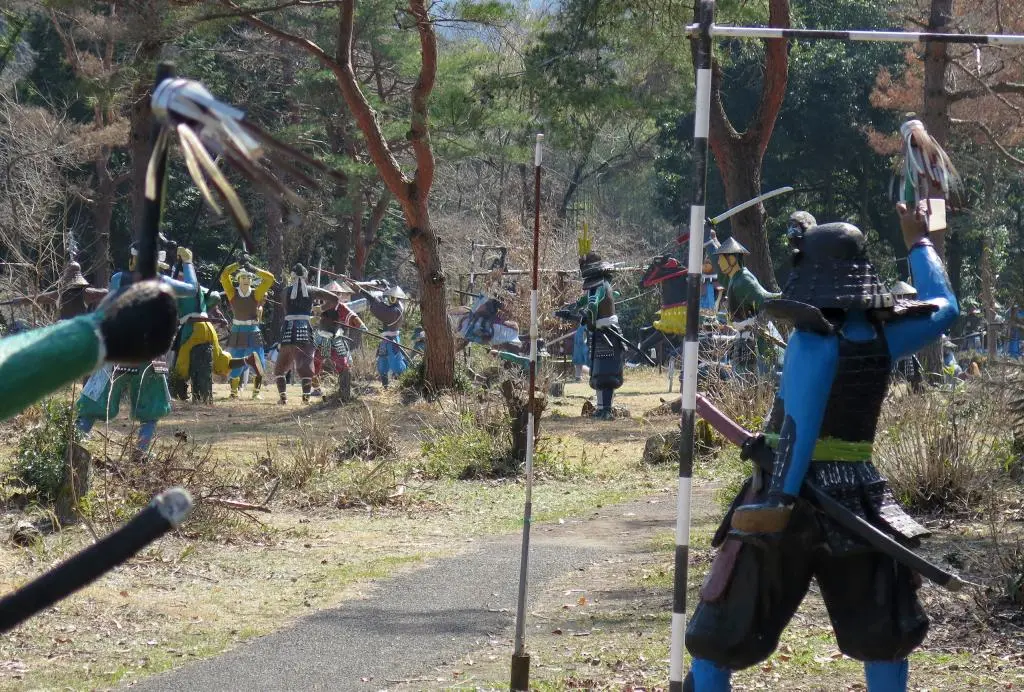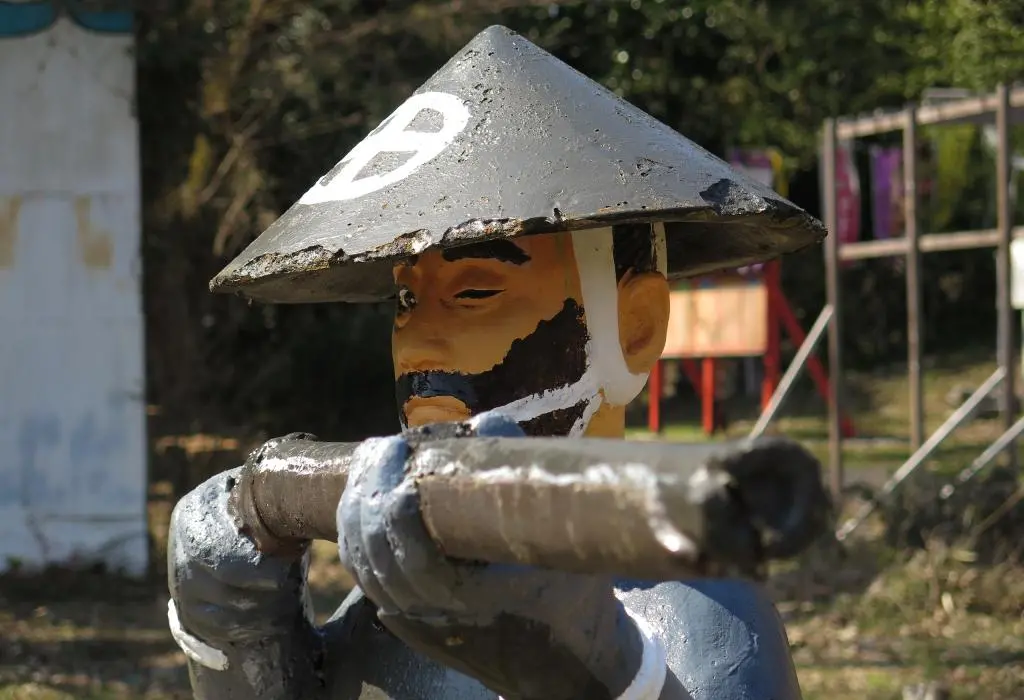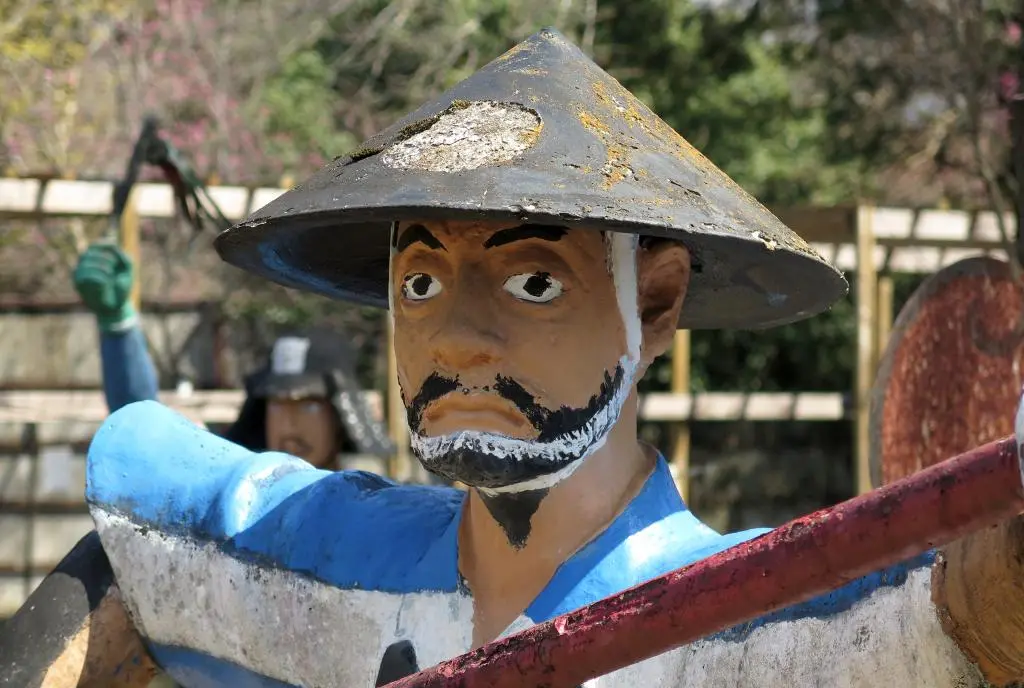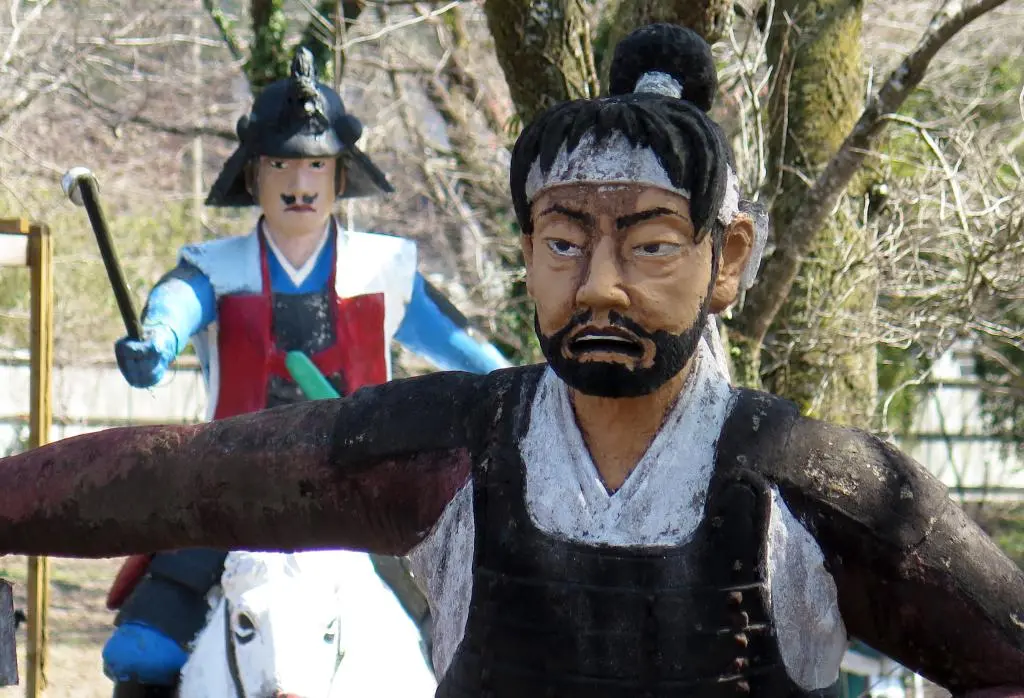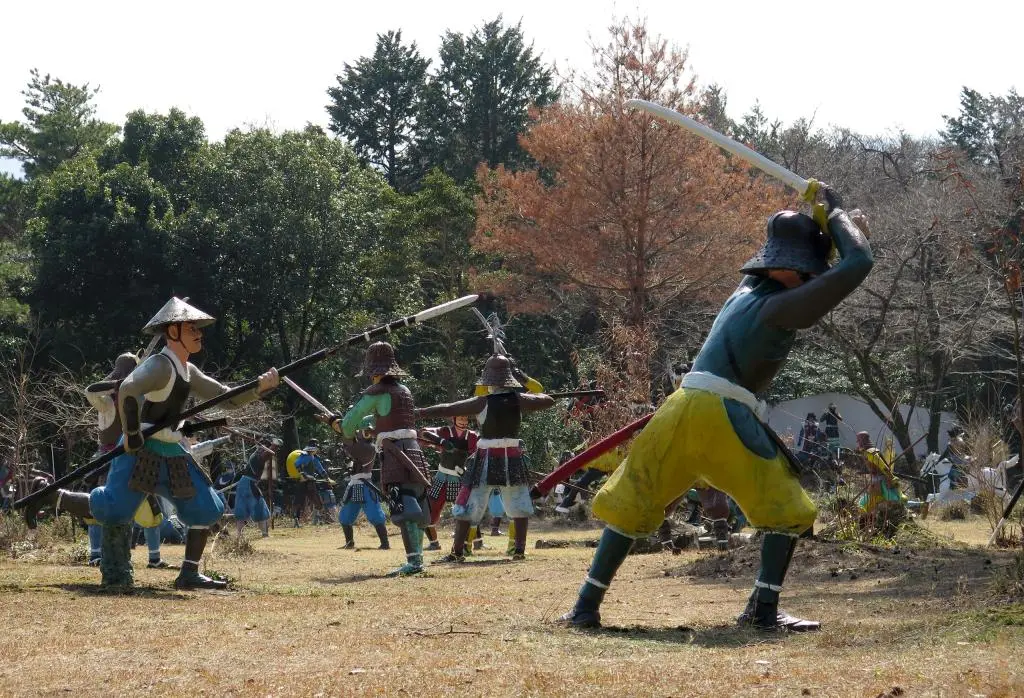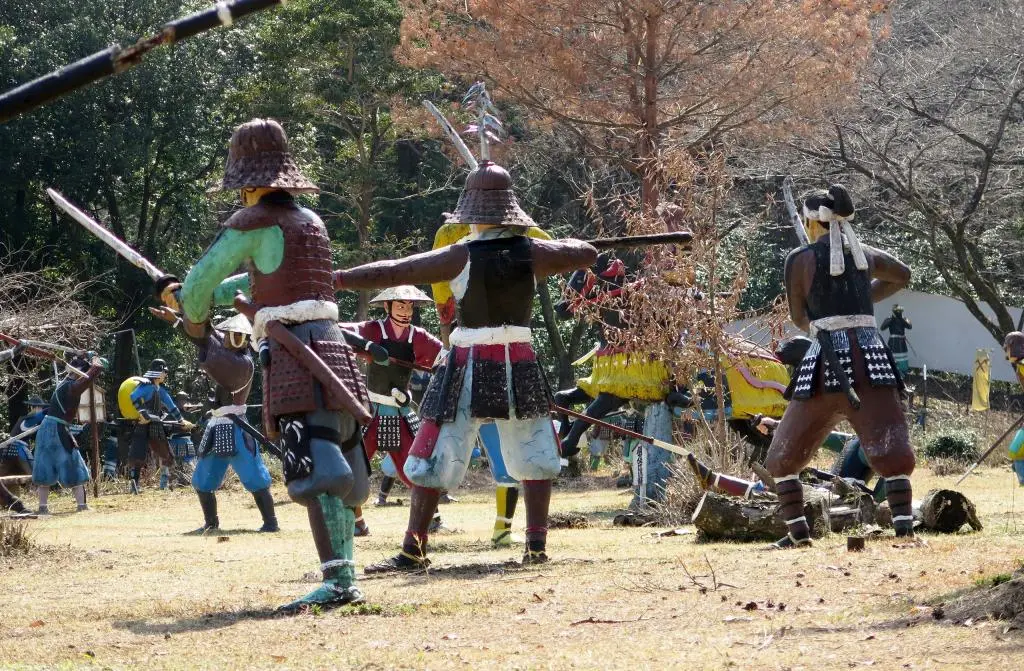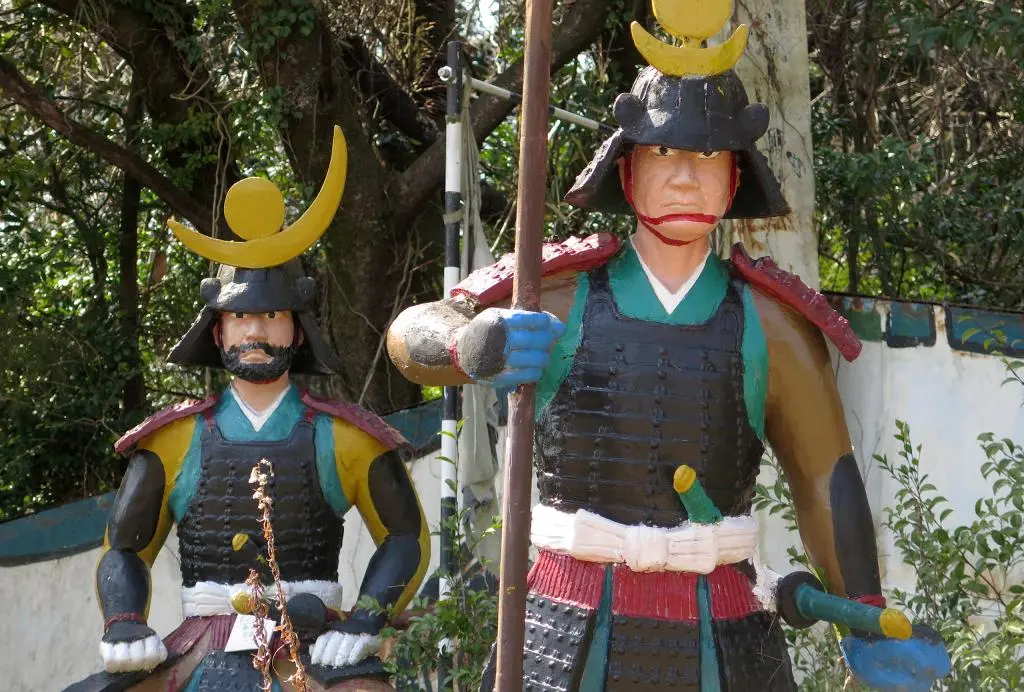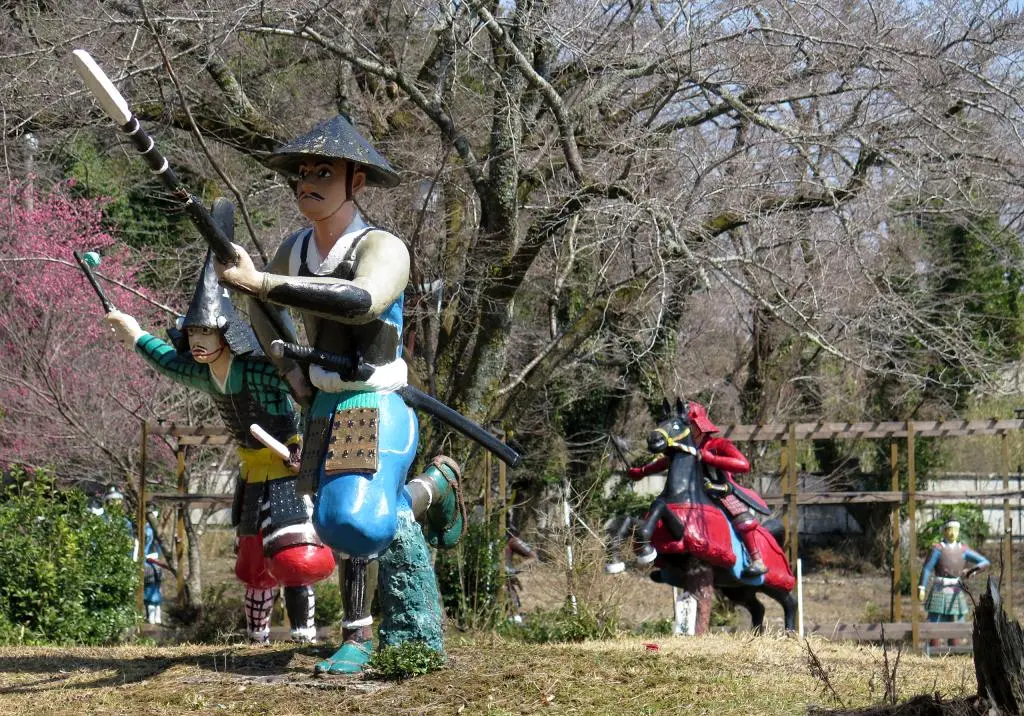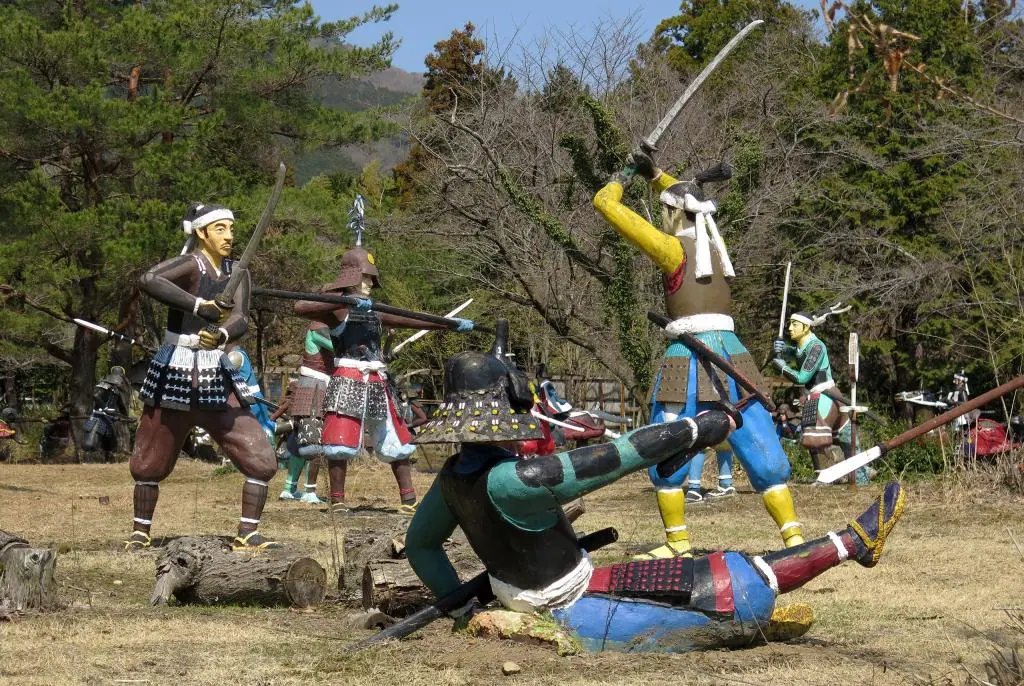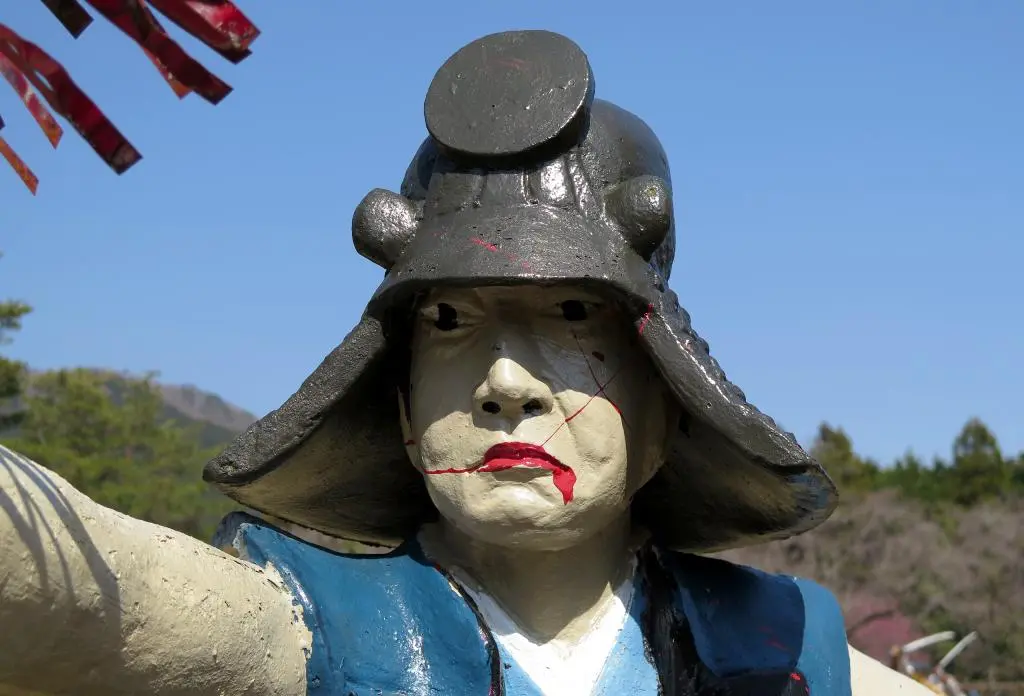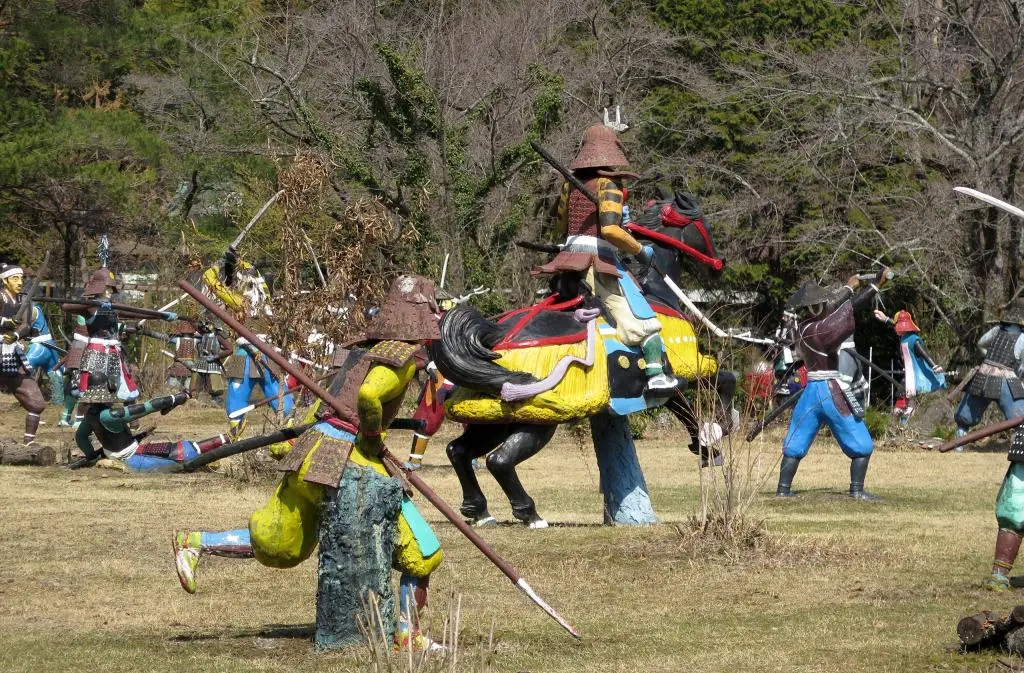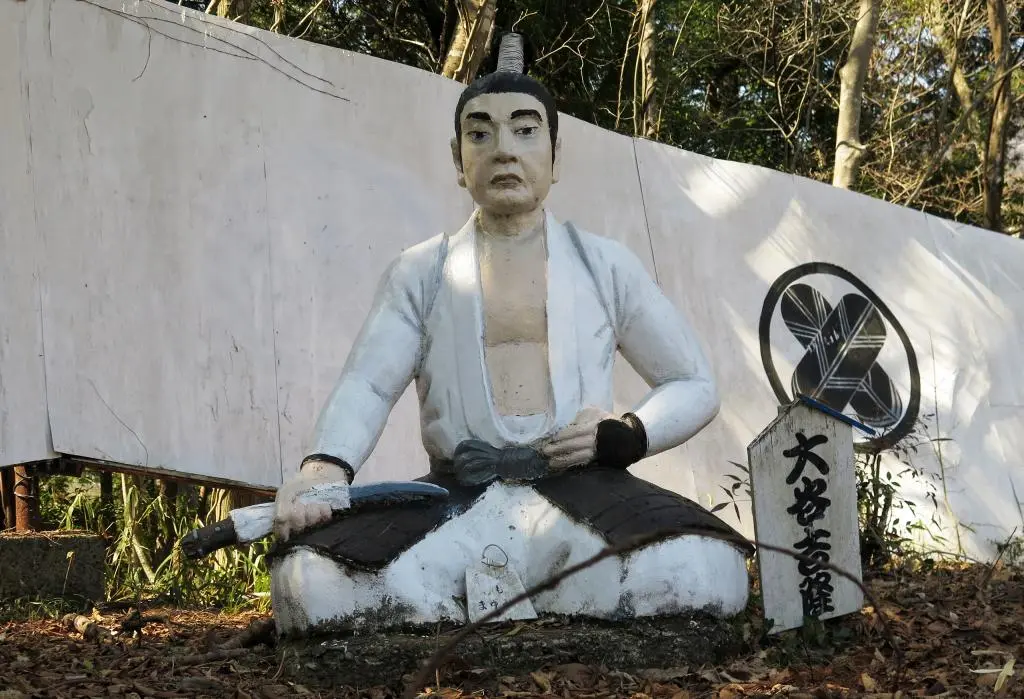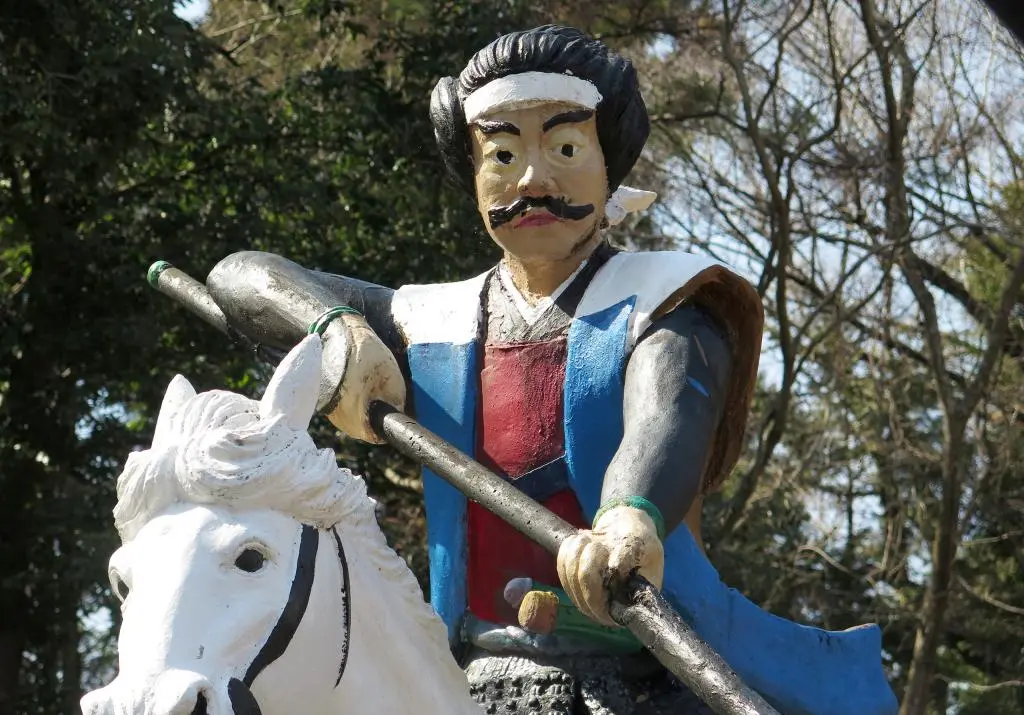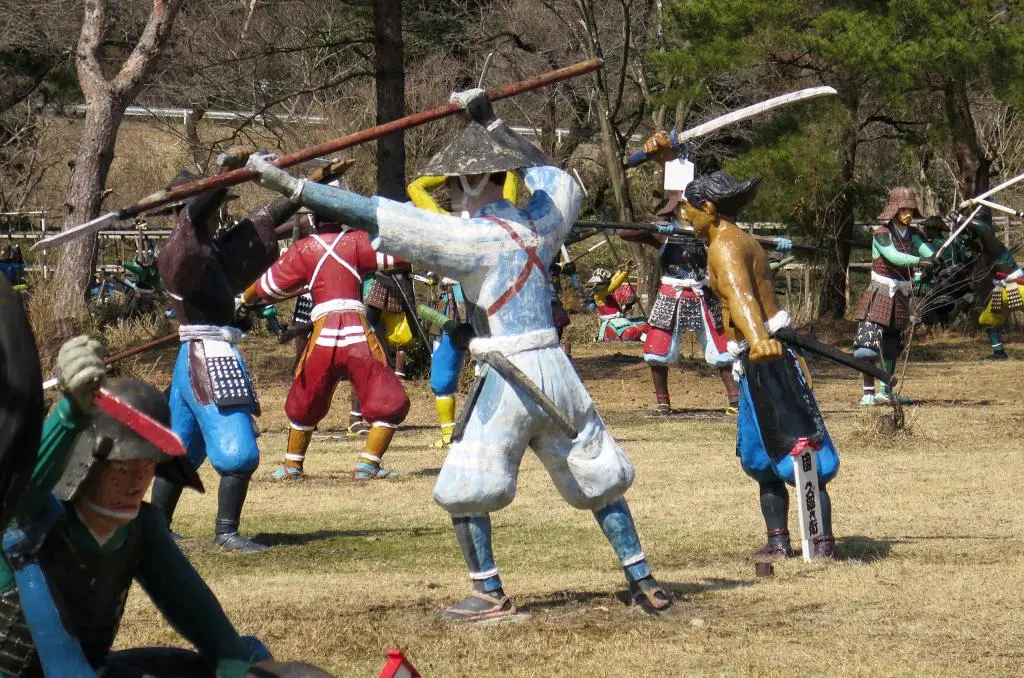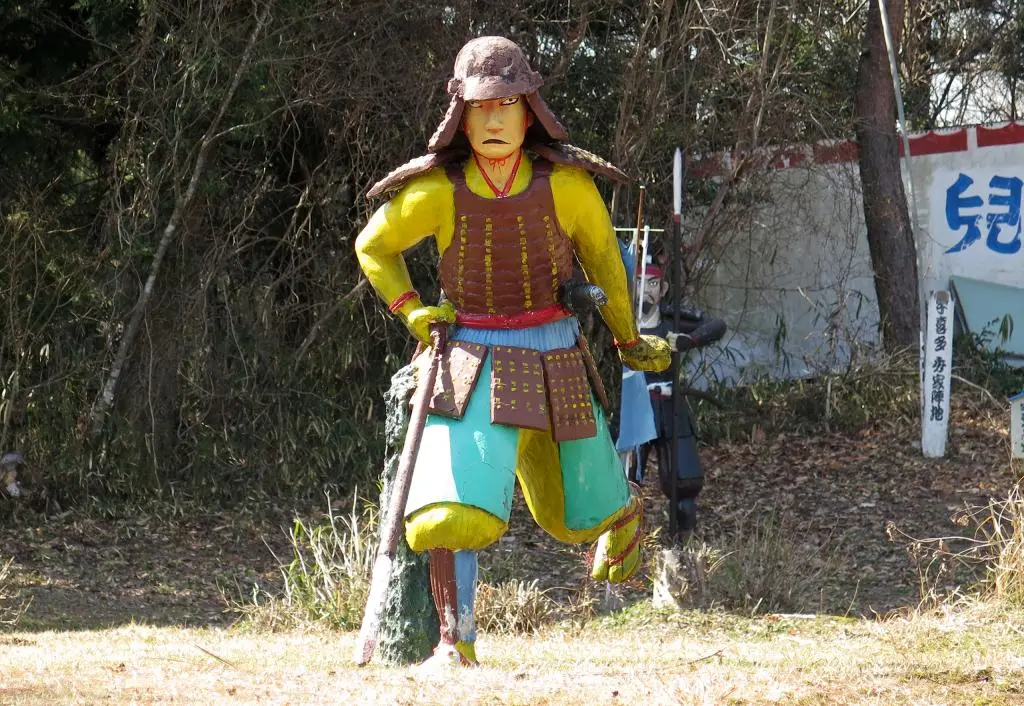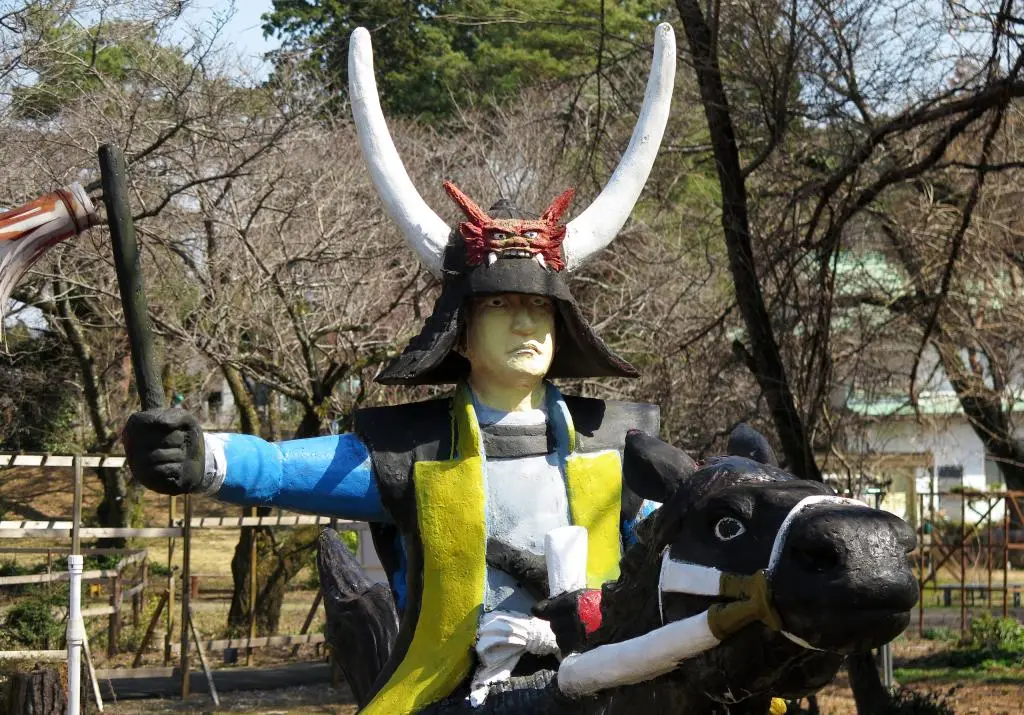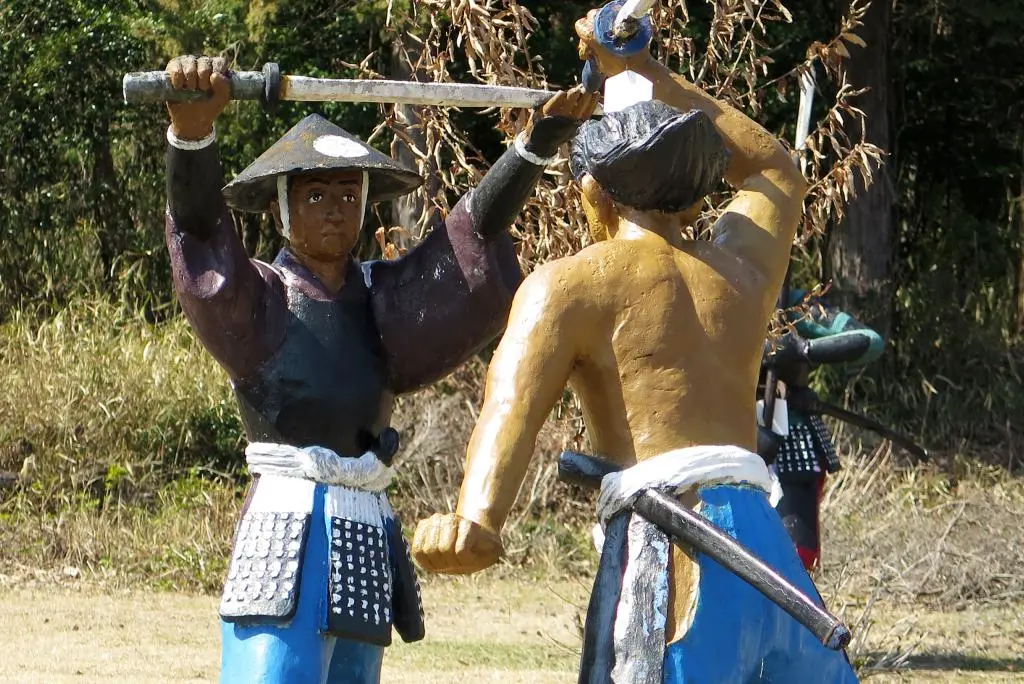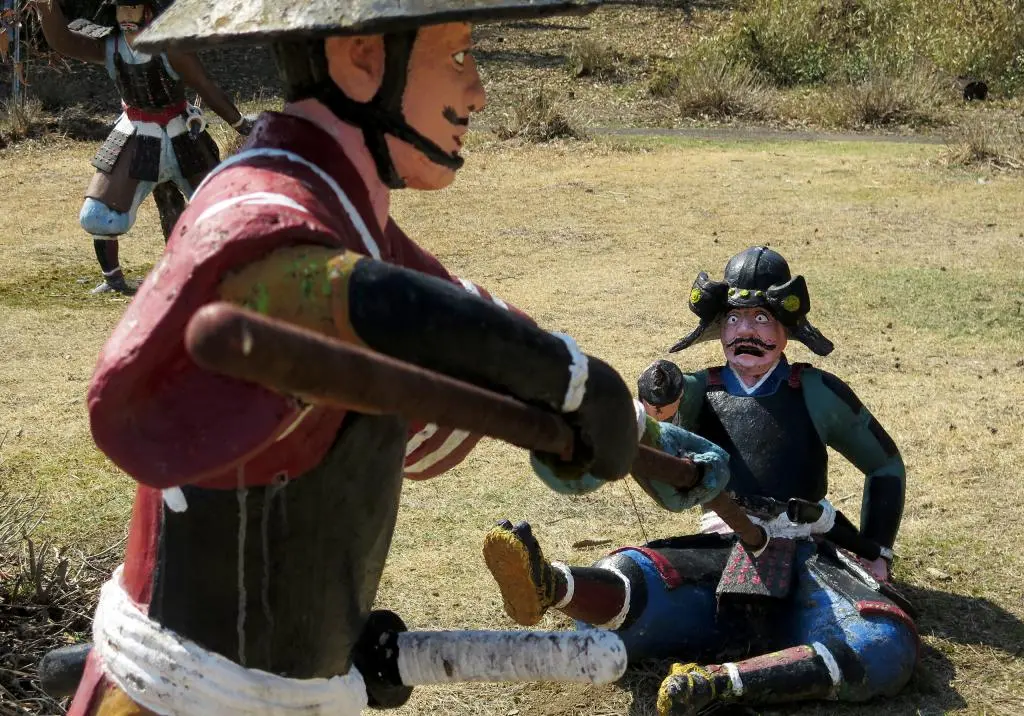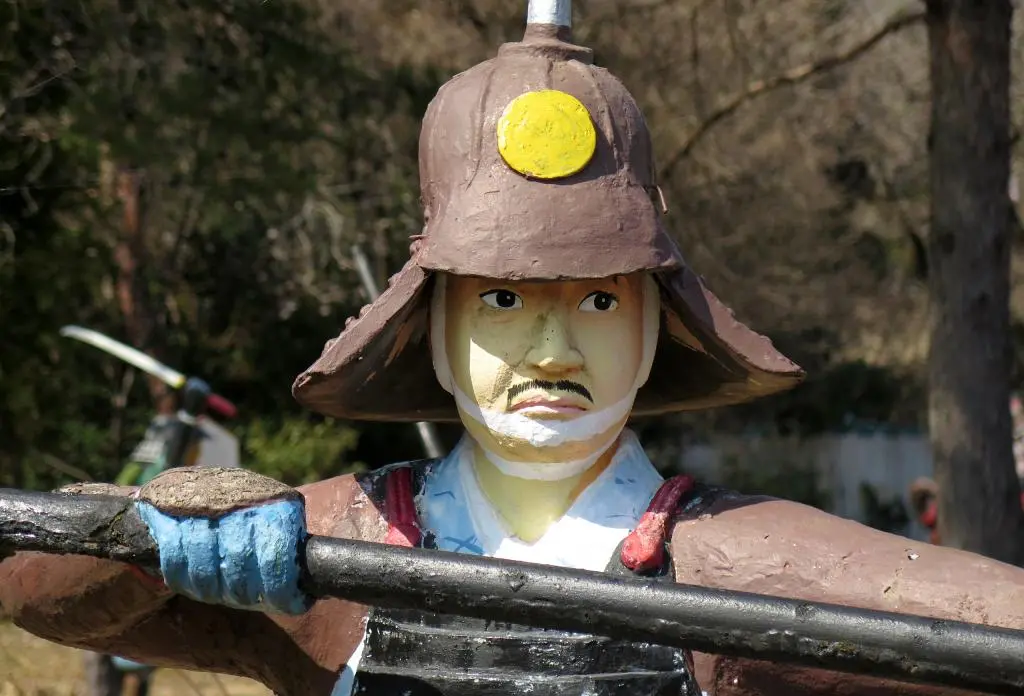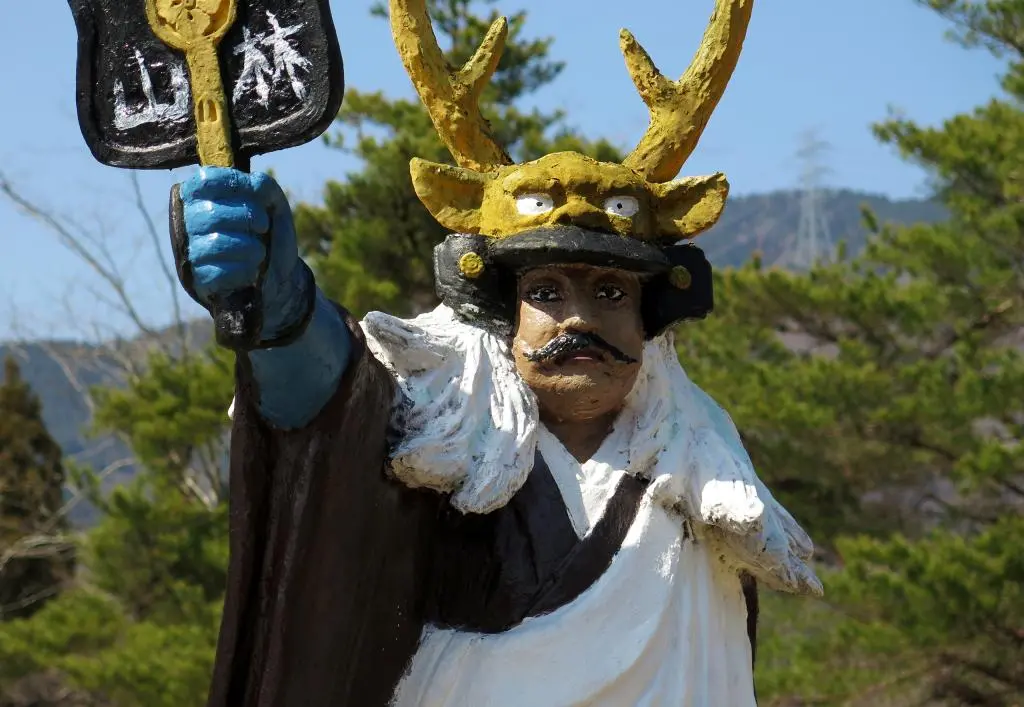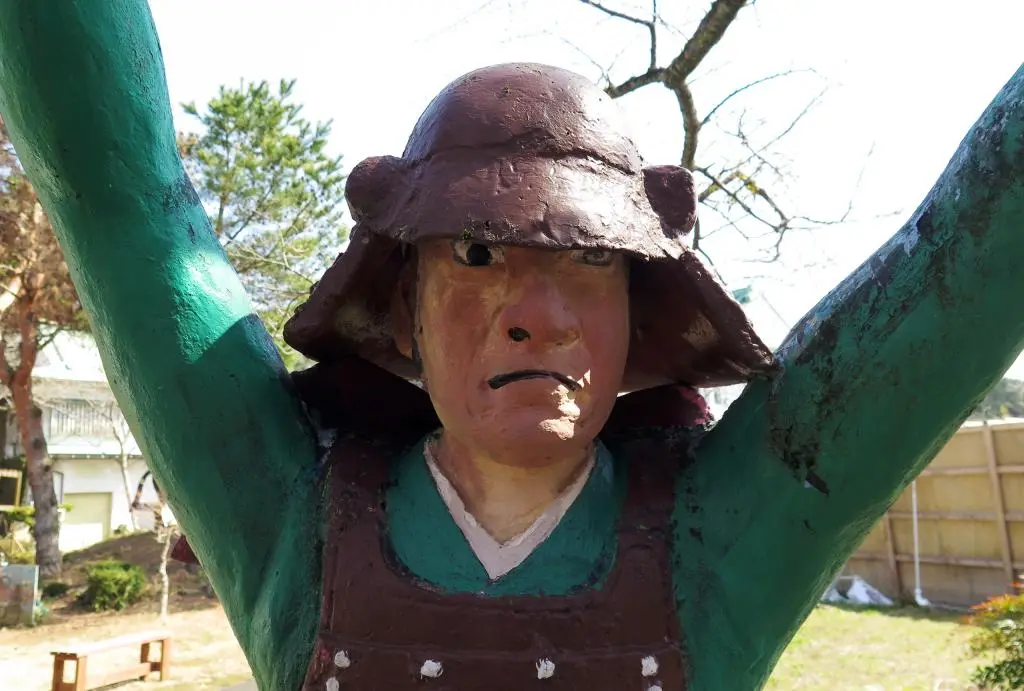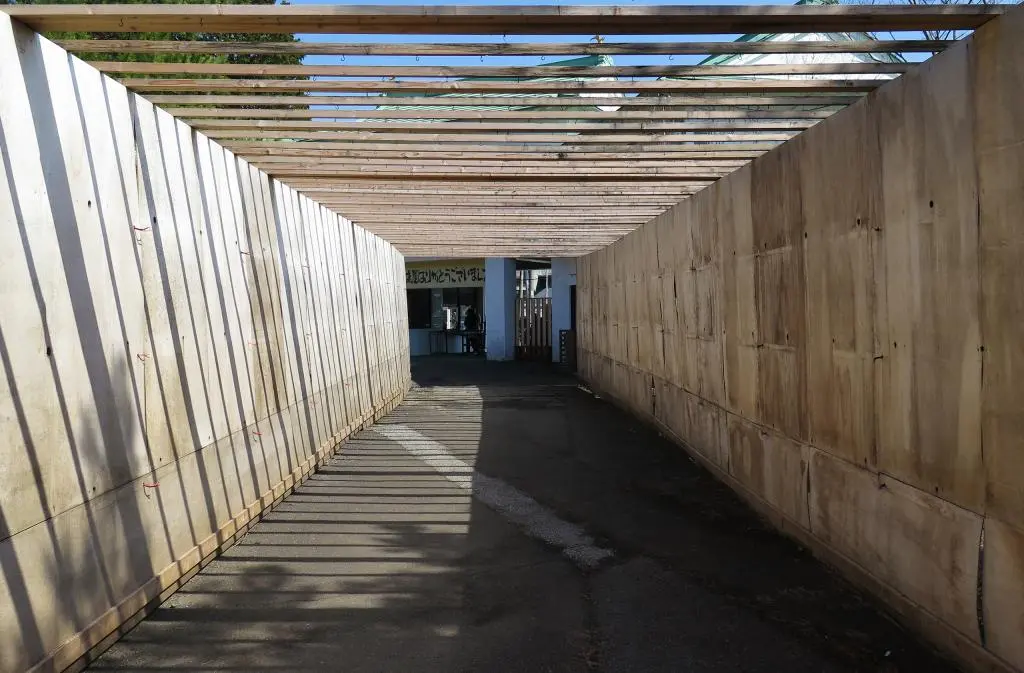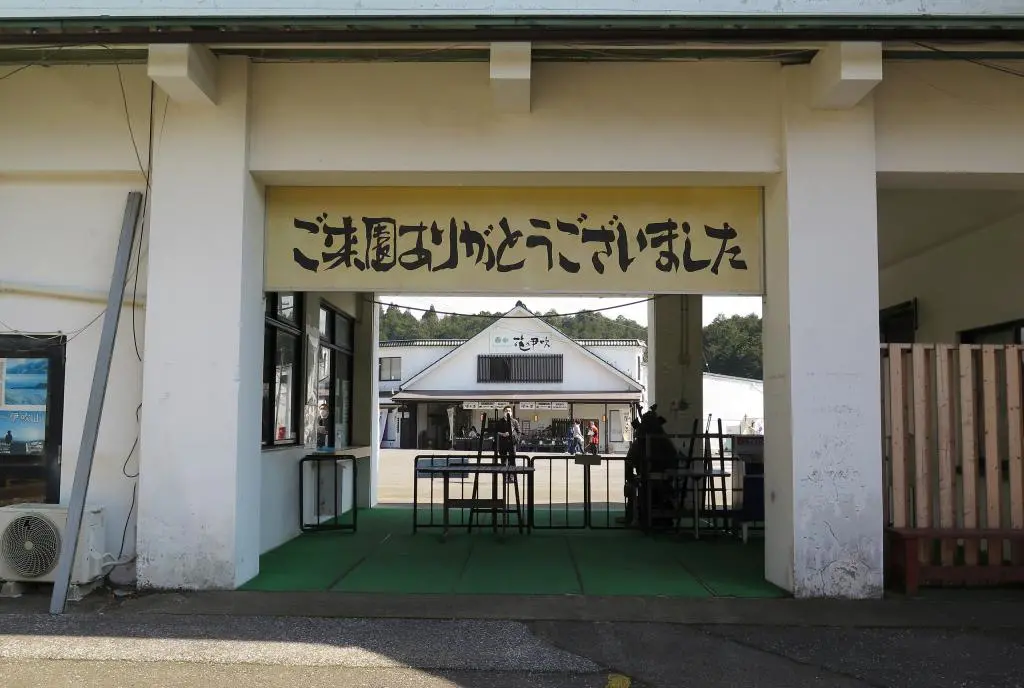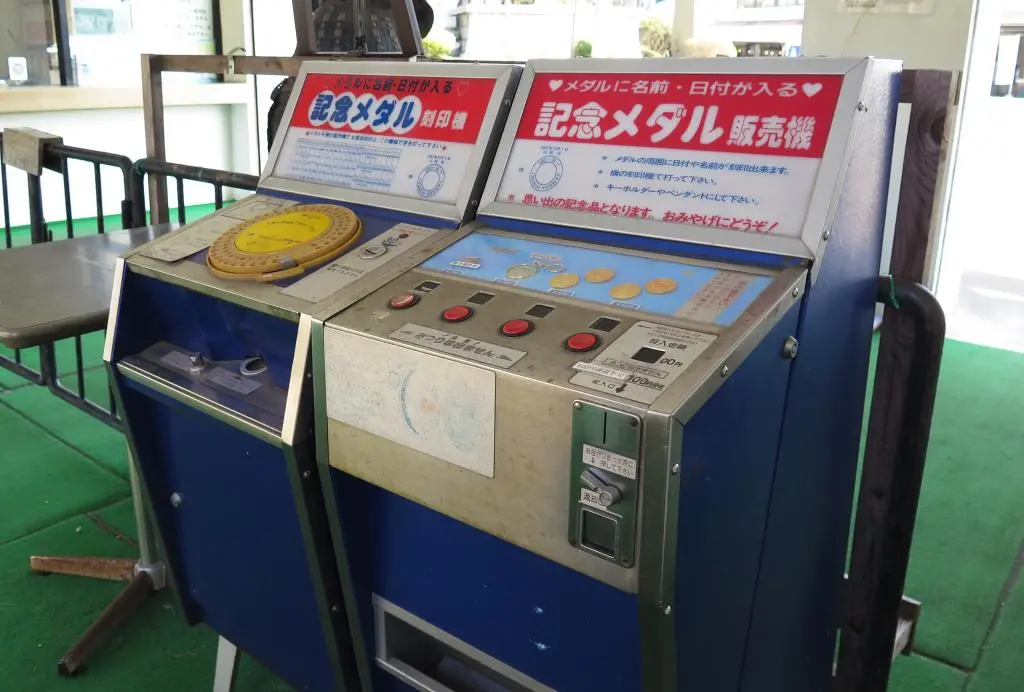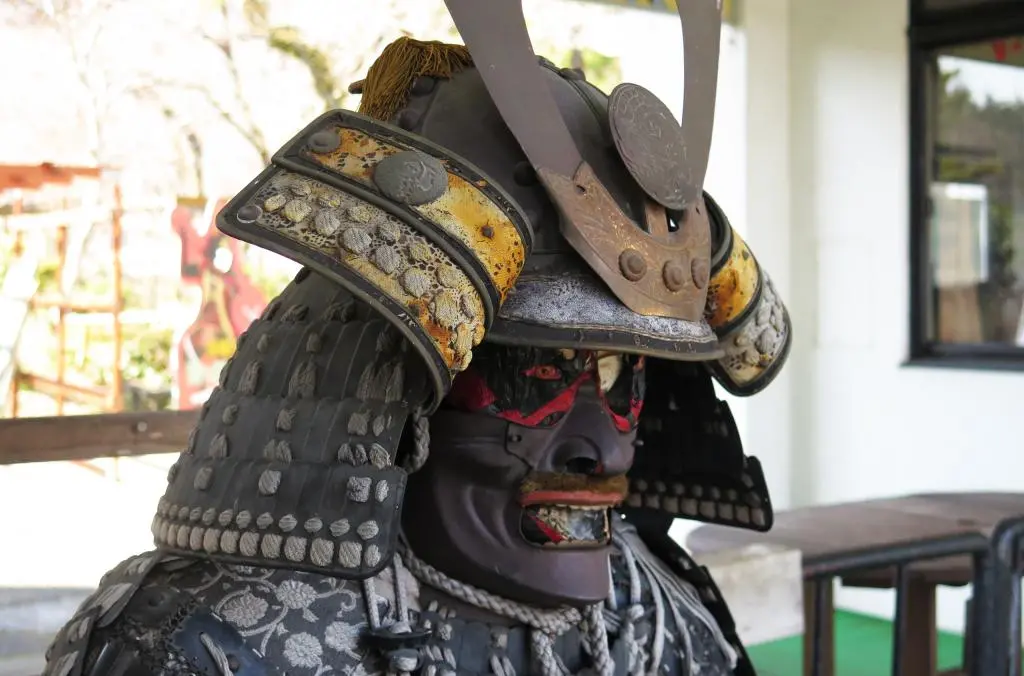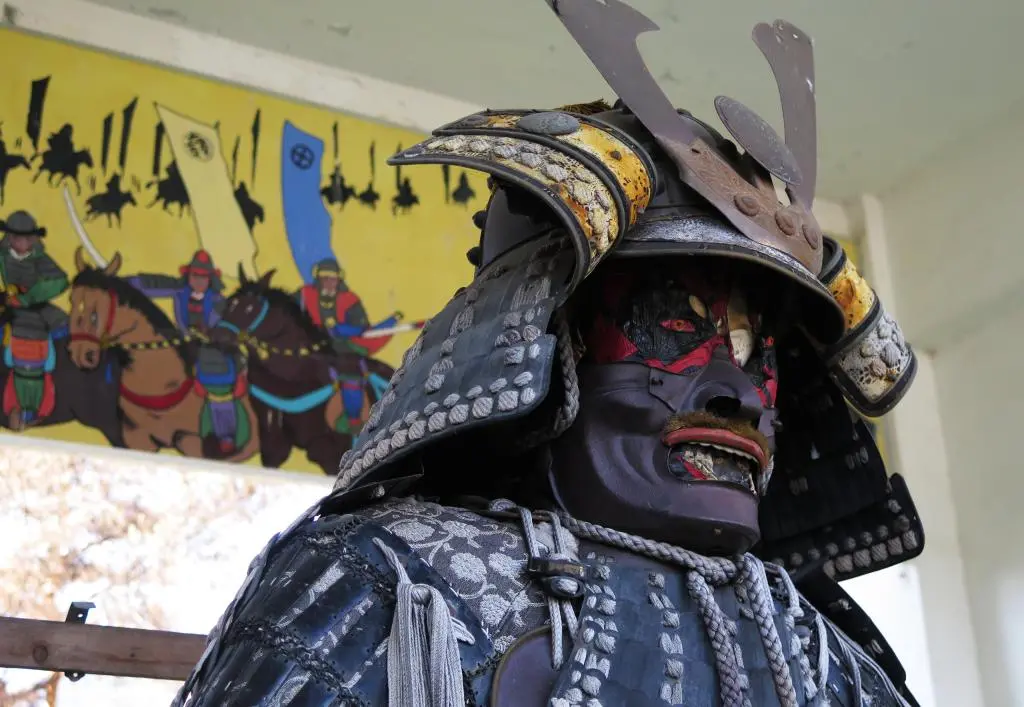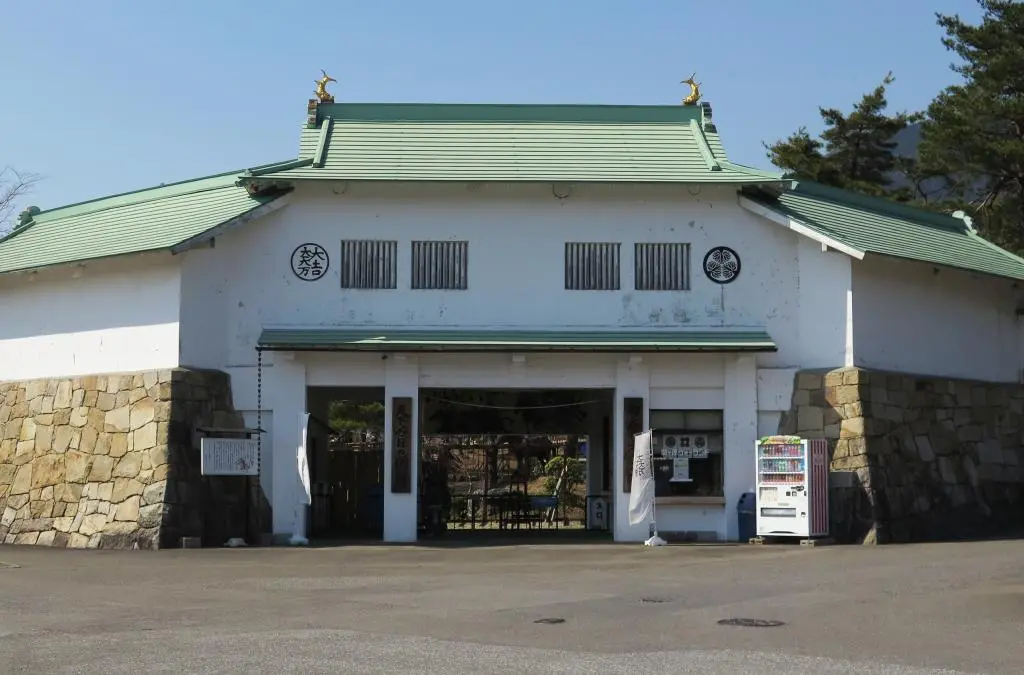Sekigahara Warland is an aging "theme park" which celebrates the Battle of Sekigahara. It first opened in 1964 and displays over 200 lifesize concrete soldiers recreating the atmosphere and intensity of the battle. Many of the major lords are present from the battle as well as several minor lords.
The park feels like a forgotten relic due to its age and general lack of upkeep or any form of modernization. The concrete figures are a huge mixed bag of quality, from the general inhuman facial details, varying degrees of skin tones (from dark brown to yellow to white to pink), and warped joints (possibly from a lack of precise molding equipment). In addition, many of the key figures of the battle whose appearance is pretty consistent across the other museums in town are very generic here.
Also, there are 60 year old coin machines at the entrance which no longer operate. There's a lecture hall whose doors barely opened. Inside the lecture hall, there's a diorama of the battle which doesn't seem like it works anymore. And the admissions desk was staffed by an apathetic old woman who seemed bothered and took her time selling me a ticket, and said nothing the whole time.
It really feels like a burnt out 80s theme park from the movies.
Many of the concrete figures have nameplates underneath them identifying who the statue is meant to represent. Unfortunately, the education ends there. Warland doesn't offer any documentation on any of the figures in their park beyond a few posted signs. It's nice there is some identification but if you don't know who these people are, there's no immediate way of finding out.
Local people probably have a good idea. Also, maybe they offered some kind of tour guide for the park? There was certainly no guide when I visited on this Saturday afternoon.
After entering Warland, there were several named statues on the hillside to the right.
Ankokuji Ekei 安国寺恵瓊 was a military monk who was close with Kobayakawa Takakage, leader of the Kobayakawa clan and who would've been a member of the Five Regeants had he not died before Toyotomi in 1598. The Kobayakawa clan was a sub-faction of the Mori clan, and with Takakage's death, Ankokuji feared the Mori clan would be wiped out with the loss of a great leader. He was happy that Mori Terumoto 毛利輝元succeeded in becoming a regeant giving them the strength to protect their survival, but this forced the Kobayakawa clan against Tokugawa as Mori supported Ishida.
Ankokuji Ekei became one of the top commanders of the Mori army and commanded his own army of 1800 troops stationed further east from the battle, planning on attacking Tokugawa's rear. In front of him was Kikkawa Hiroie 吉川広家.
That's this guy. Kikkawa Hiroie was head of the Kikkawa clan, also a sub-faction of the Mori clan. It is said that through his diplomacy and politics he was able to keep the peace between the sub-factions of the Mori clan after Kobayakawa Takakage's death. On the day of the Battle, as mentioned above, his army of 4200 was stationed in front of Ankokuji and the whole of the Mori army.
Mori's retainers supported Ishida and the other Toyotomi loyalists, but it was clear to Kikkawa that they would lose the battle. Kikkawa made a secret pact with Kuroda Nagamasa 黒田長政 of the Tokugawa army that if he prevented the Mori armies from joining the battle, the Mori clan would be spared and be able to keep their domains. So, when the Mori clan gave Kikkawa the order to attack, he refused. And his refusal prevented the rest of the Mori clan from engaging in the battle.
This is Mori, by the way, but not Mori Terumoto 毛利輝元, who was one of the Five Regeants. This is his cousin Mori Hidemoto 毛利秀元. Terumoto never joined the battle and stayed in Osaka Castle. Hidemoto was determined to support Ishida of the Western Army and brought 15,000 soldiers of his army to the battle. But, because of Kikkawa's inaction, he was prevented from attacking.
After the battle, the whole secret pact fell apart because Mori never agreed to it. It was only Kikkawa who put forth the idea to Kuroda and Tokugawa. As such, the Mori clan lost 75% of its territories after Tokugawa became Shogun, and they labeled Kikkawa as a traitor. Ankokuji, still fiercely loyal to the Western Army, was executed in Kyoto with Ishida weeks after the battle.
After the Battle finished and Tokugawa was the victor, he led the Head Viewing Ceremony. It was necessary for each soldier to bring the head of all his opponents he killed to the commander to pay respects to the fallen enemy and to get properly rewarded for his success in battle.
Tokugawa set up his folding chair in the field and his commanders and advisors surrounded him. Here, Tokugawa sits and looks at a head brought to him for inspection. The deceased is identified, and the head is respectfully wrapped in cloth and laid to rest in a mound with his fellow soldiers.
A few of the commanders around him were as follows.
Kuroda Nagamasa 黒田長政 was the eastern's army chief military strategist. He signaled the start of the Battle which ordered the front lines of the Eastern Army to engage the west. Spotting weaknesses in the Eastern Army, he ordered his gunman to attack Ishida's troops directly, keeping them concentrated in the field ahead. But, more notably, he schemed with both Kobayakawa and Kikkawa to undermine the Western Army's strength and eventually destroy itself.
Monnashi Saburo 門奈三郎 is a member of the Monnashi clan, a military clan derived from the Fujiwara clan that I don't think existed at the time of the battle. I could not find any information about Saburo himself.
There were many others, but I didn't recognize the names at the time, and I could not find any information about the other names that I did make note of.
From the above two scenes, the park opened up into the full battle with its various localized skirmishes.
Above, Kuroda Nagamasa commanded his troops along with Takenaka Shigekado 竹中重門 to cover Ishida's flank. Takenaka was 21 years old at the time of the battle, but worked closely with Kuroda to keep the battle concentrated in the field in front of them. After the battle, he captured Konishi Yukinaga 小西行長, one of the top commanders in the Western Army. Konishi was then executed with Ishida and Ankokuji.
Shima Sakon 島左近, along known by a few other names, was stationed at Sasaoyama alongside Ishida's army. He was one of Ishida's best friends and Ishida used him as a leading strategist for the Western Army. He was known as one of the bravest generals in Ishida's army, so I'm not sure why they protrayed him as a goofball above. It is said that he was shot by Kuroda's gunman when they attacked, so maybe they modeled him after that moment.
Shima's body was never recovered after the battle, so we don't know if he immediately died of his gunshot wounds, or if he survived and lived a few more years in hiding.
This was the main station of Ishida's forces. Ishida was in back, and this guy in the front has a nameplate, but I have no idea who it is. The closest person I could find was Ujiie Yukihiro 氏家行広, who used the nickname Kyuuasemon 久左衛門. It's not perfect, but the kanji 氏家久左衛門 is pretty close.
Ujiie planned on joining the Eastern Army with Tokugawa, but with his kingdom in the path of the Western Army, he returned to his home and his family joined with Ishida. According to Wikipedia, he never joined the battle, so this is further confirmation it's not the right person.
After the battle, the Ujiie clan was dissolved, and Yukihiro became a ronin. In the shadows, he still supported the efforts of those still fighting against Tokugawa. He fought against Tokugawa in the seige of Osaka Castle in 1614, but committed seppuku when the battle was lost.
In the open field, the Shimadzu clan attacks. They are pretty easy to spot with their circled crosses.
The Shimadzu clan army was split into two factions led by Shimadzu Yoshihiro 島津義弘 and nephew Shimadzu Toyohisa 島津豊久. Both were fiercely loyal to Ishida and fought with the same intensity.
In the distance is Katou Yoshiaki 加藤嘉明. Katou was one of the seven generals who plotted to assassinate Ishida after the death of Toyotomi. Kuroda was in this group, too. With the loss of the Korean war, Ishida wrote terrible performance reviews about them, calling them imcompetant for the loss. Tokugawa used this opportunity to shield Ishida from their wraith, but then gained their loyalty when it was clear he would war against Ishida.
Lots of fighting going on.
In the front is Fukushima Masanori 福島正則, another one of the seven general alongside Katou and Kuroda. In the Battle, he was given the right to led the Eastern Army against Ishida's Western Army. However, Ii Naomasa 井伊直政 and Matsudaira Tadayoshi 松平忠吉 had their gunman fire on the Eastern Army prior to the start of the battle, which enraged Fukushima to start the battle immediatley.
Futher in the back is Miyamoto Musashi 宮本武蔵, a legendary Japanese swordsman who eventually wrote The Book of Five Rings 五輪の書 detailing the essence of true swordsmanship in both technique, attitude, and personal philosophy. His ideals led to the creation of modern Budo culture. Scholars believed the he had participated in the Battle of Sekigahara and the creators of Warland thought so, too.
Warland depicts Musashi and his father as fighting for the Western Army, which was the prevailing idea at the time as he was a longtime vassal of the Ukita clan. However, according to Wikipedia, after studying Kuroda's personal records of the battle, scholars have Musashi's father as serving Tokugawa's army instead. Scholars claim that having Musashi fighting for the West was always a romanticized ideal of him being an amazing ronin warrior fighting for the heart of Japan, but facts do not point to this.
Kani Saizo 可児才蔵 was a commander in Fukushima's army. According to Wikipedia, he often killed so many men, that he couldn't carry all of their heads with him. As such, after their deaths, he would place bamboo leaves over their cut necks or mouths as his calling card. After the battle, other soldiers counted 17 felled opponents with bamboo leaves on them. His nickname became Bamboo Saizo.
The key moment of the Battle of Sekigahara when Tokugawa's Eastern Army's victory was assured was around Noon when the Kobayakawa clan made their intentions to defect from the Western Army, join the Eastern Army, and attack the southern flank of the Western Army.
Kobayakawa Hideaki 小早川秀秋 was only 19 years old at the time of the battle and led the Kobayakawa clan. He brought 15,000 troops to the battle and was stationed on Matsuo-yama overlooking the whole battlefield from the south. As mentioned above, his father, Kobayakawa Takakage, was a high ranking member with the Toyotomi government and the Mori clan. He would've been a member of the Five Regeants, had he not passed away a year before Toyotomi's death.
With Takakage's death, Hideaki became in charge of the Kobayakawa clan. As Ishida began raising his army against Tokugawa, Tokugawa grew seeds of betrayal with Hideaki. He claimed that Ishida was responsible for the embarassment he suffered for a defeat a few years prior. On the day of the Battle, Hideaki was still indecisive whether or not to go through with his betrayal. It is said that fake gunfire from Tokugawa finally pushed him into riding down the hill and attacking the Western Army.
Hiratsuka Tamehiro 平塚為広 fought for the Western Army against Tokugawa. Hiratsuka was loyal to the Toyotomi family, but was hestitate to enter a war with Tokugawa. Both he and Otani tried to convince Ishida not raise an army against him, but Ishida did not listen. His loyalty brought him and his 600 soldiers to the Battle.
Hiratsuka was the first army in the path of Kobayakawa. He was killed in the attack. His death is often over shadowed by Otani's.
Otani Yoshitsugu 大谷吉継 was great friends with Ishida, so it was only natural that he would serve his friend to the bitter end. Even though he tried his best to convince his friend not to war against Tokugawa, he did not abandon him.
Otani also had leprosy which made him severely ill. In public, he would wear a white hood to cover his diseased face. At the time of the battle, his disease had advanced to the point where he could barely stand and could barely see. After being told that the battle was lost, he committed seppuku.
The amount of major people, schemes, intrigue, and shere chaos and death of the battle is pretty incredible. Every major and minor person involved in the battle had some reason for their involvement in the fight and a consequence after.
I wonder how much of this stuff was documented when the park opened in the 1960s, or how much this stuff was taught to the people who visited. In many ways, the main Battle of Sekigahara Museum is an evolution of this site, as it shows the build-up and progression of the battle using film and projectors. In comparison, Warland is a primitive way of showing almost the same thing.
However, it's still an incredible place. The Battle Museum does show the intensity of the battle, but when you're in the field of around 200 lifesize concrete soldiers, you can feel the scale and chaos of the battle. Being able to walk around and view the individual people involved, and (later) being able to look up who they were, humanizes the battle, too.
It's a shame that there isn't more education about all the named people in the park, but I think it's still definitely worth a visit.
